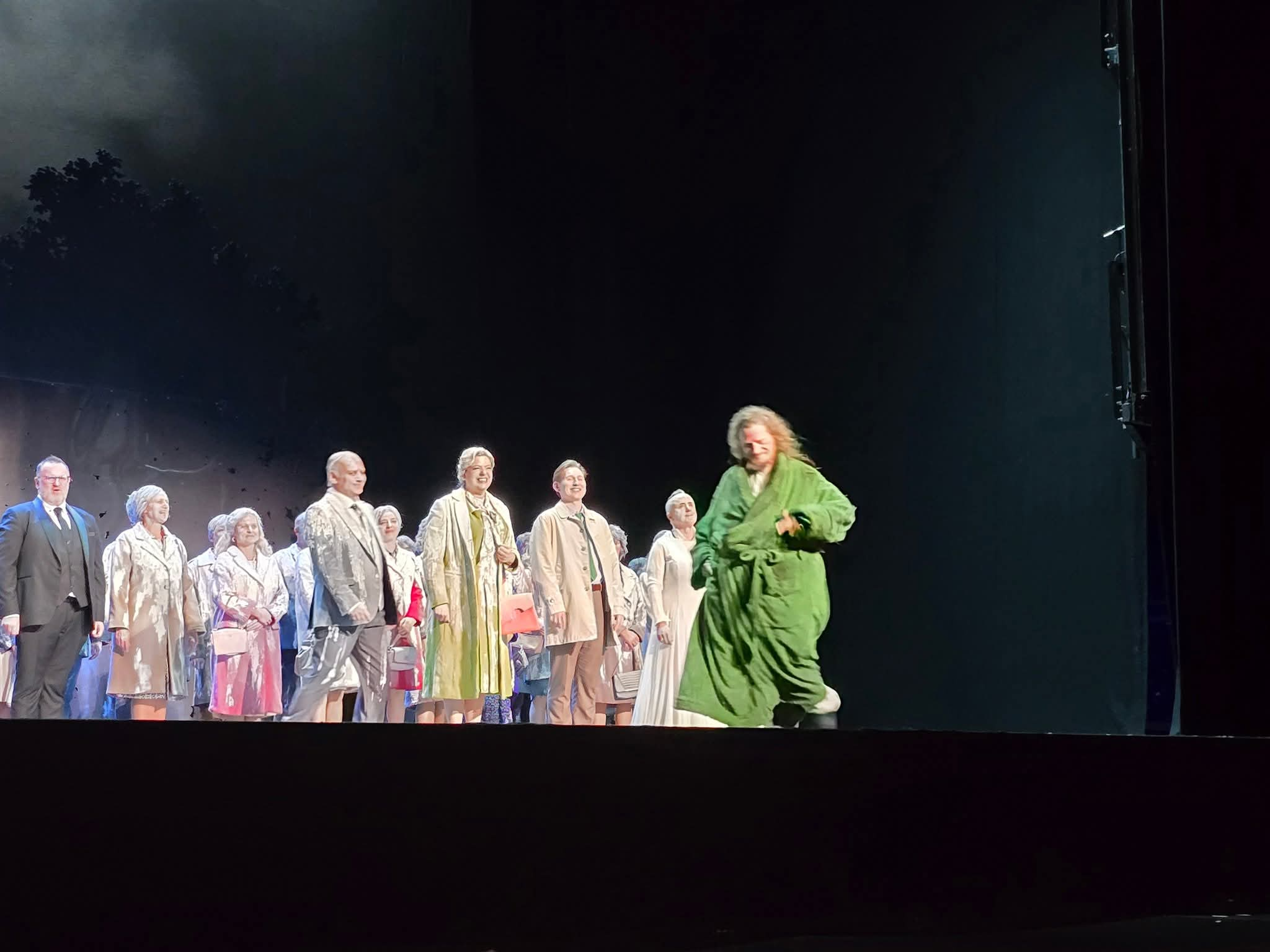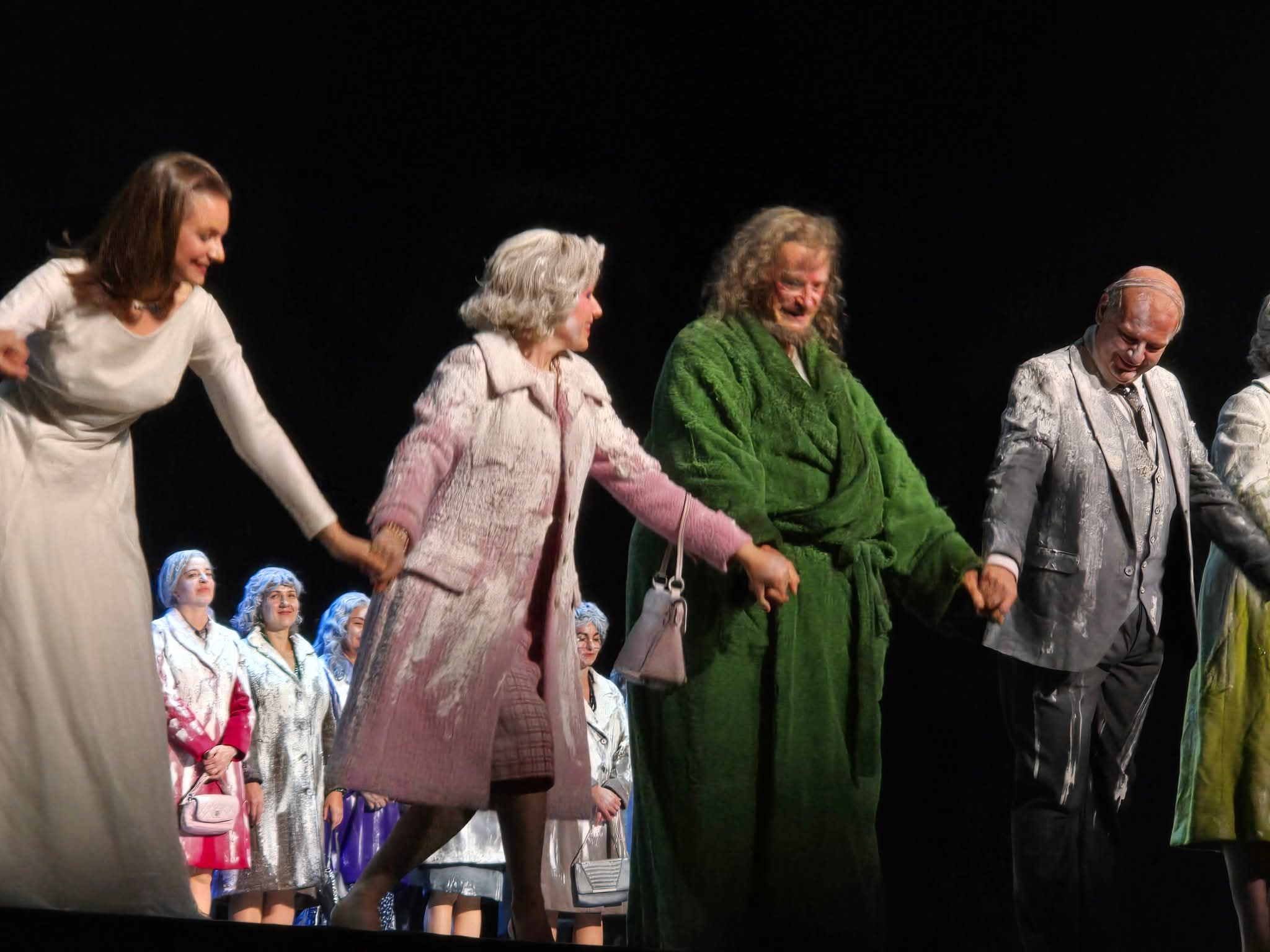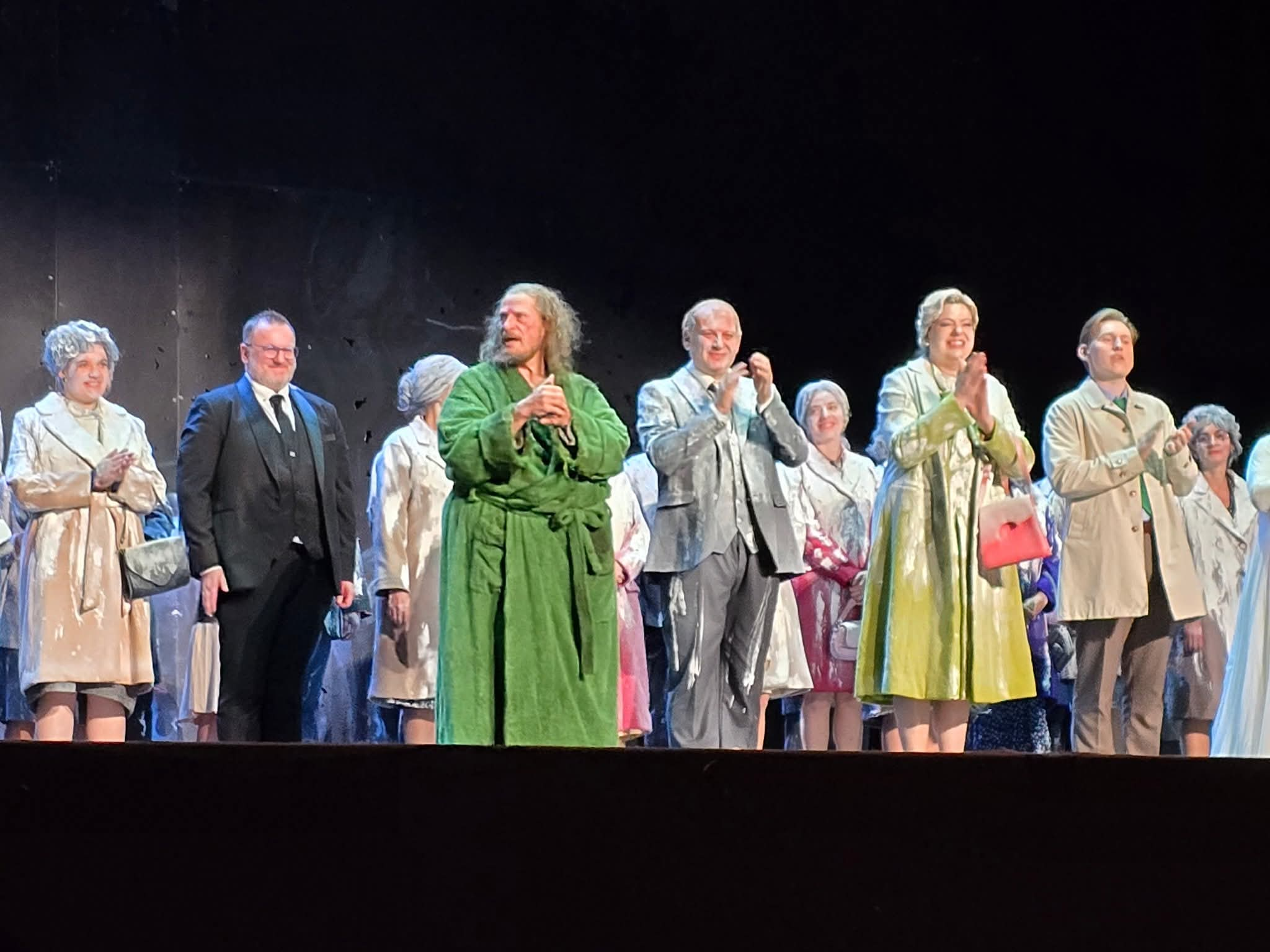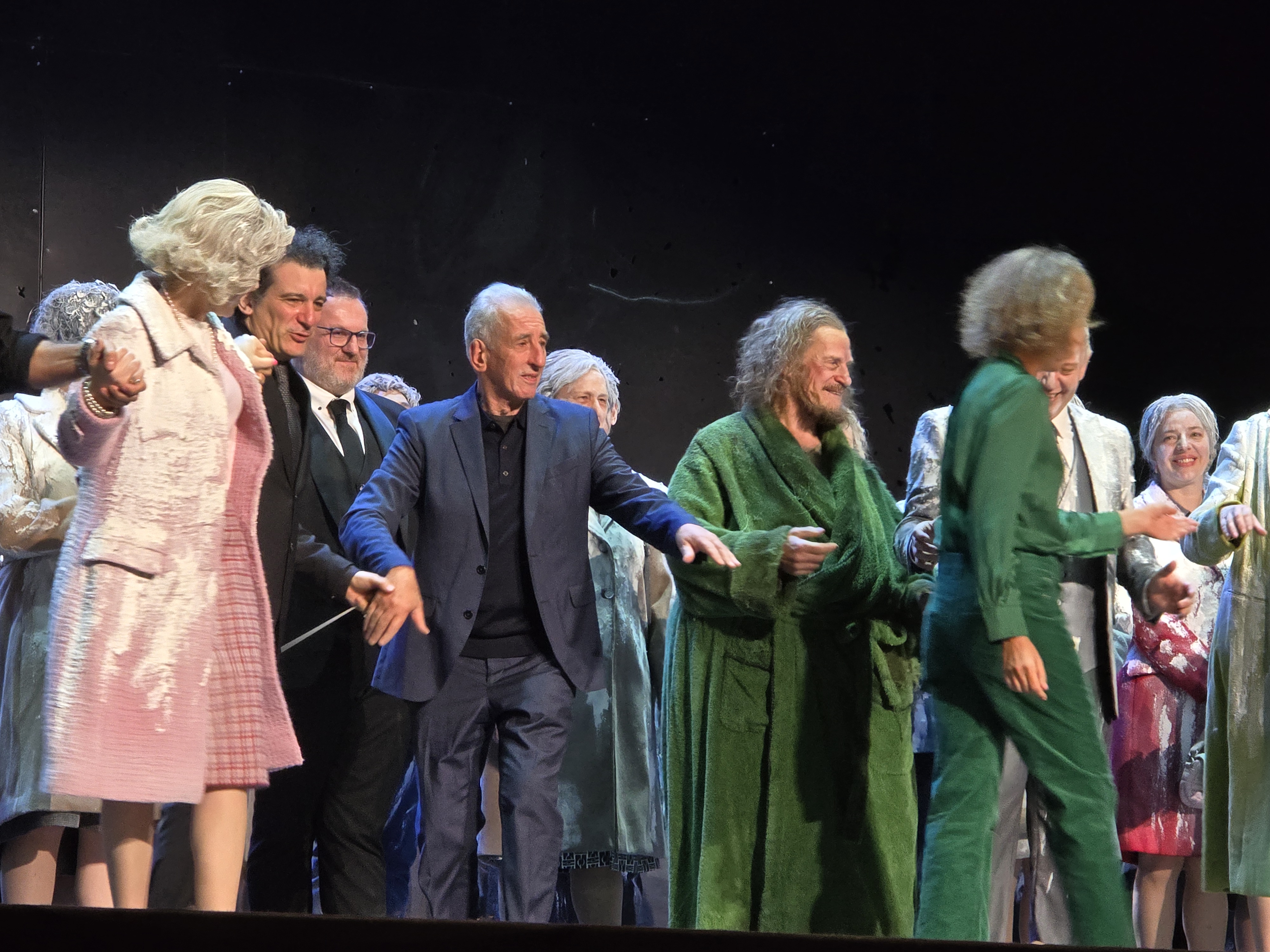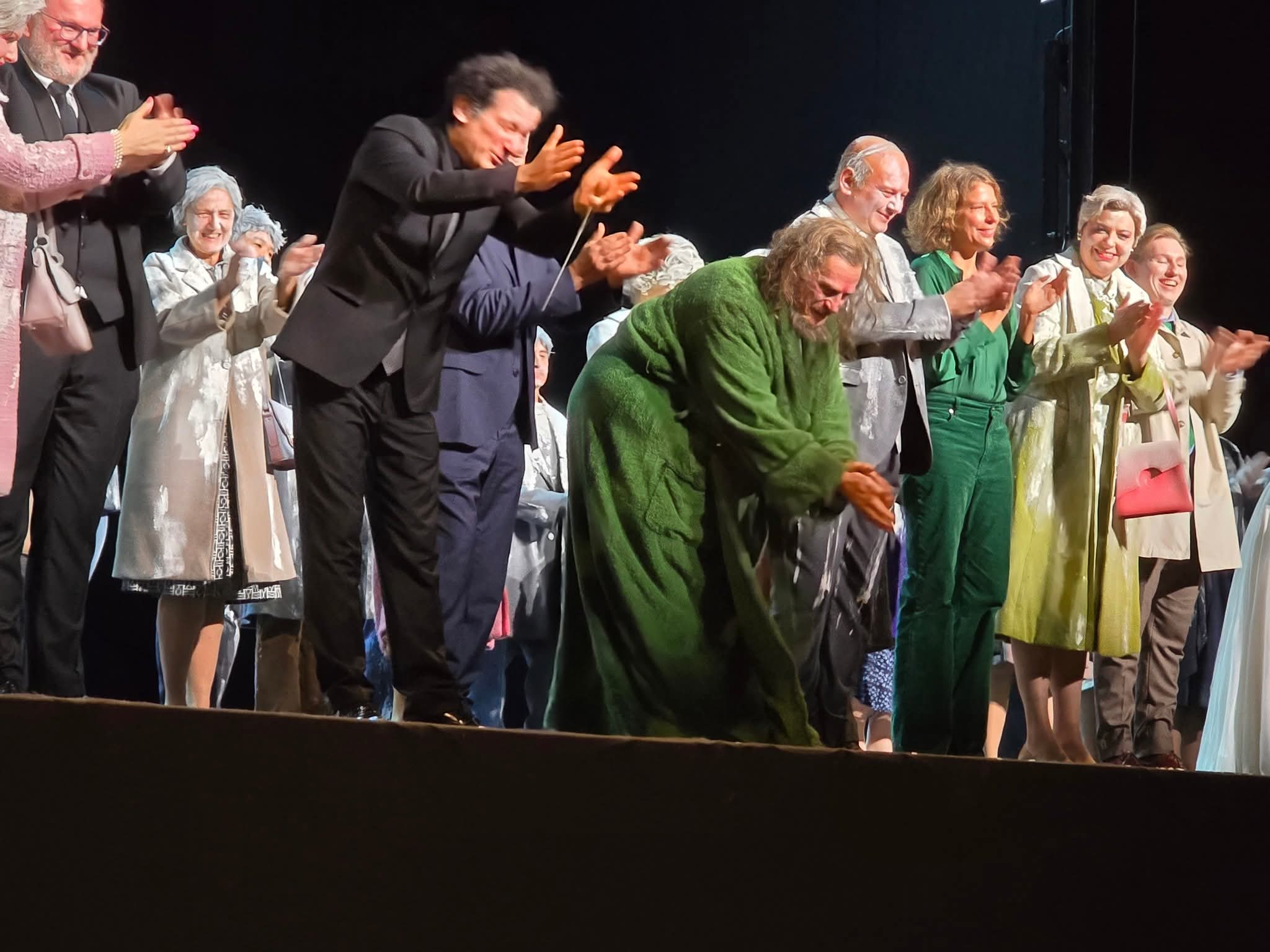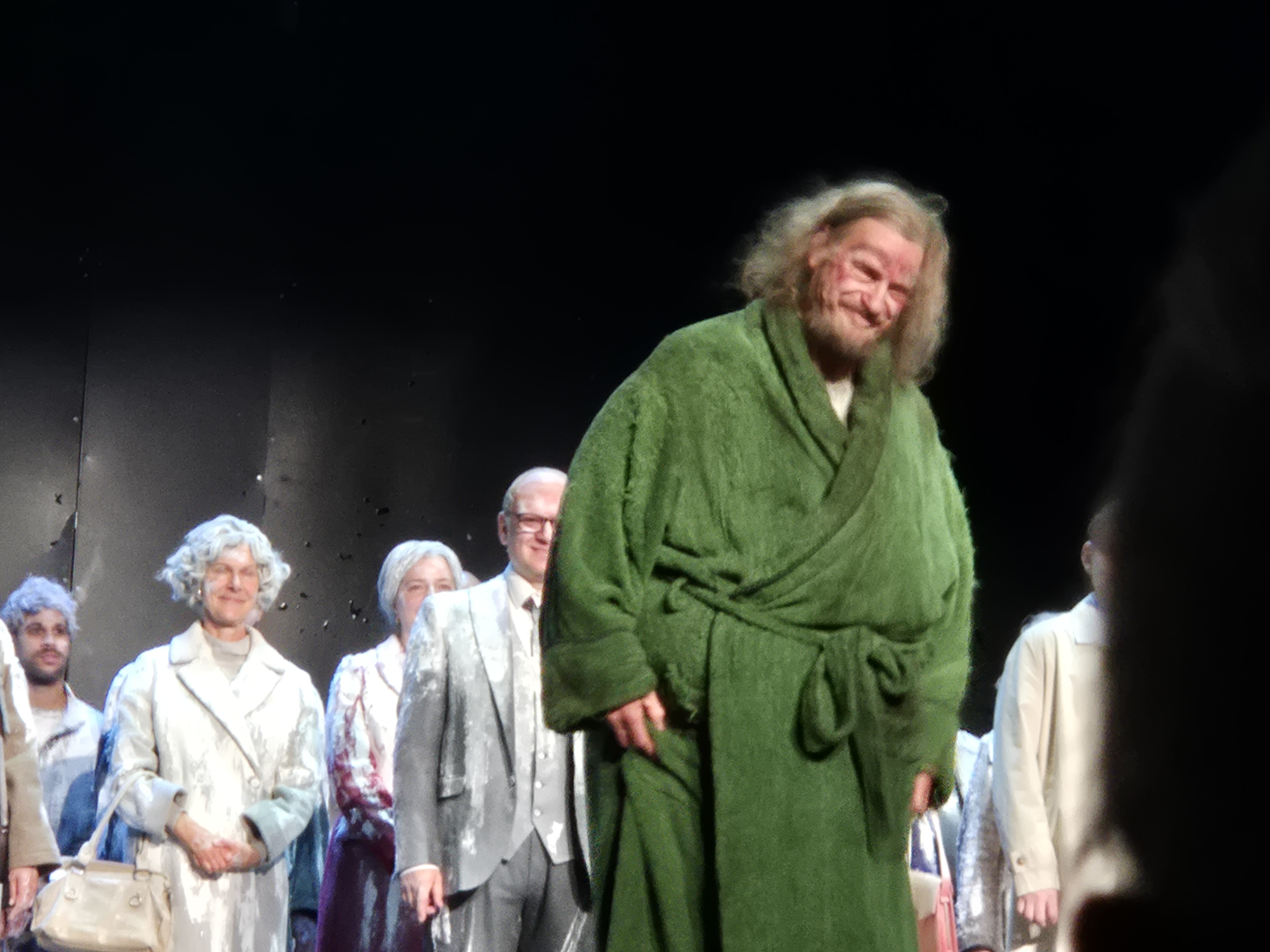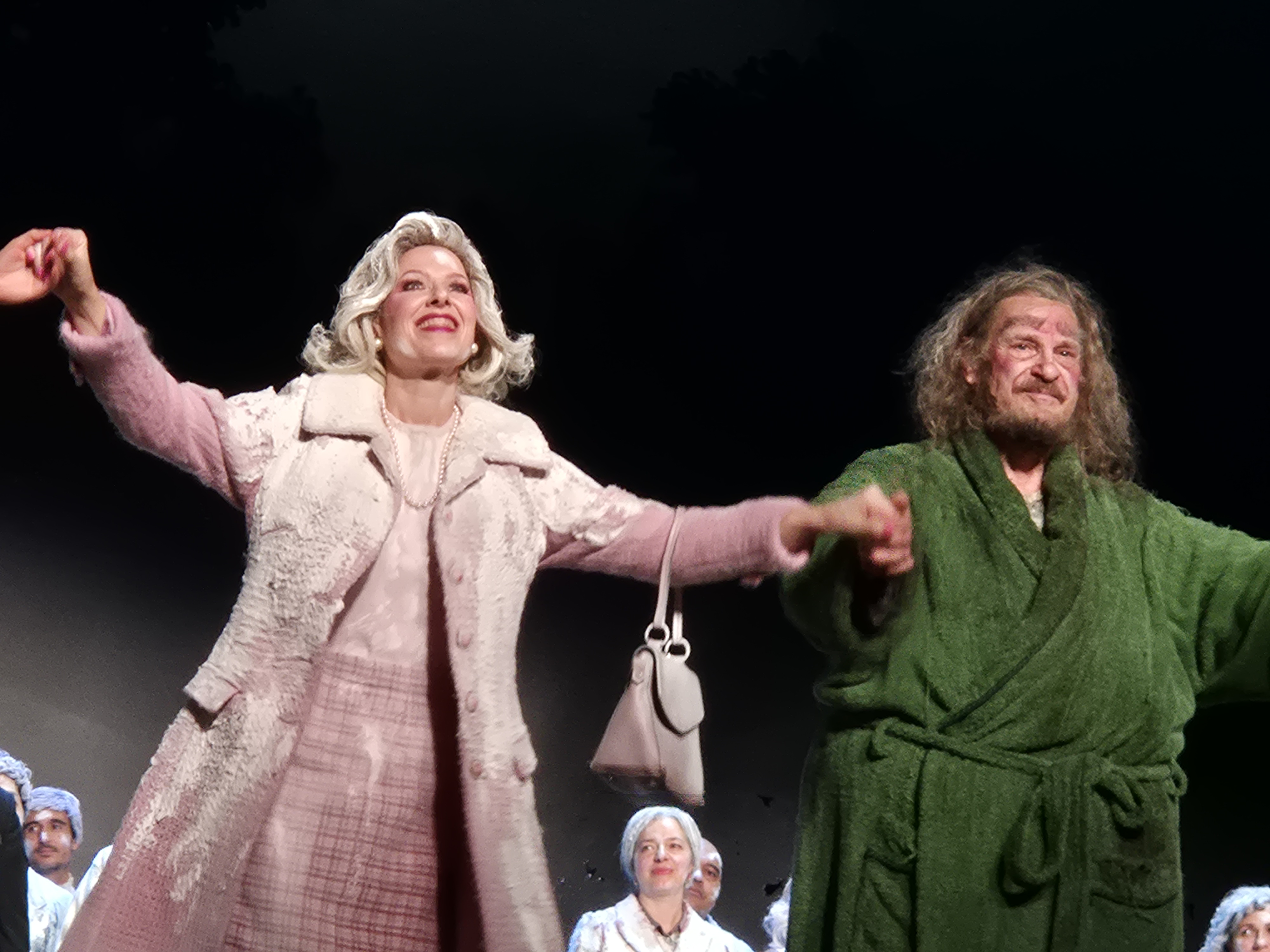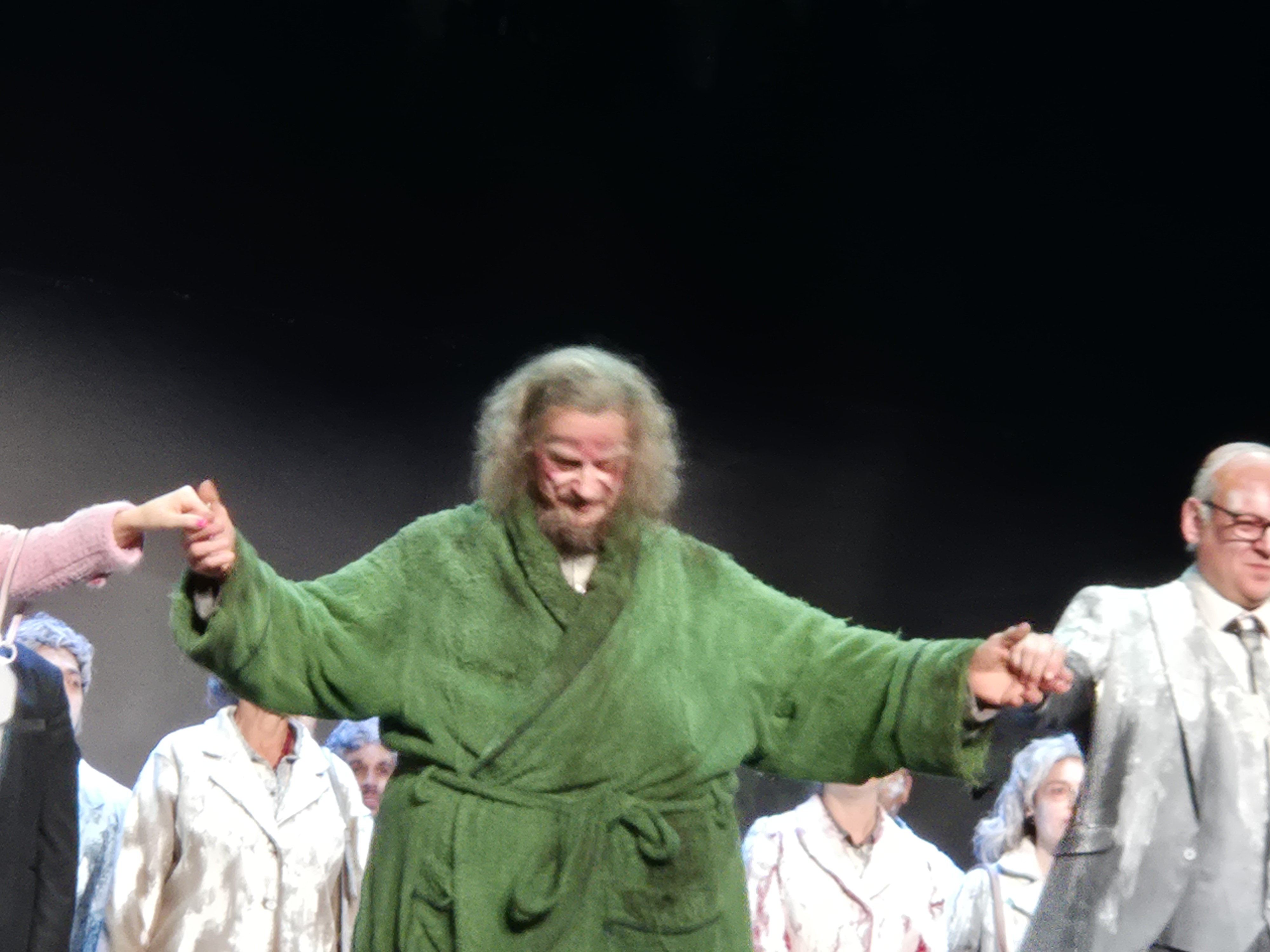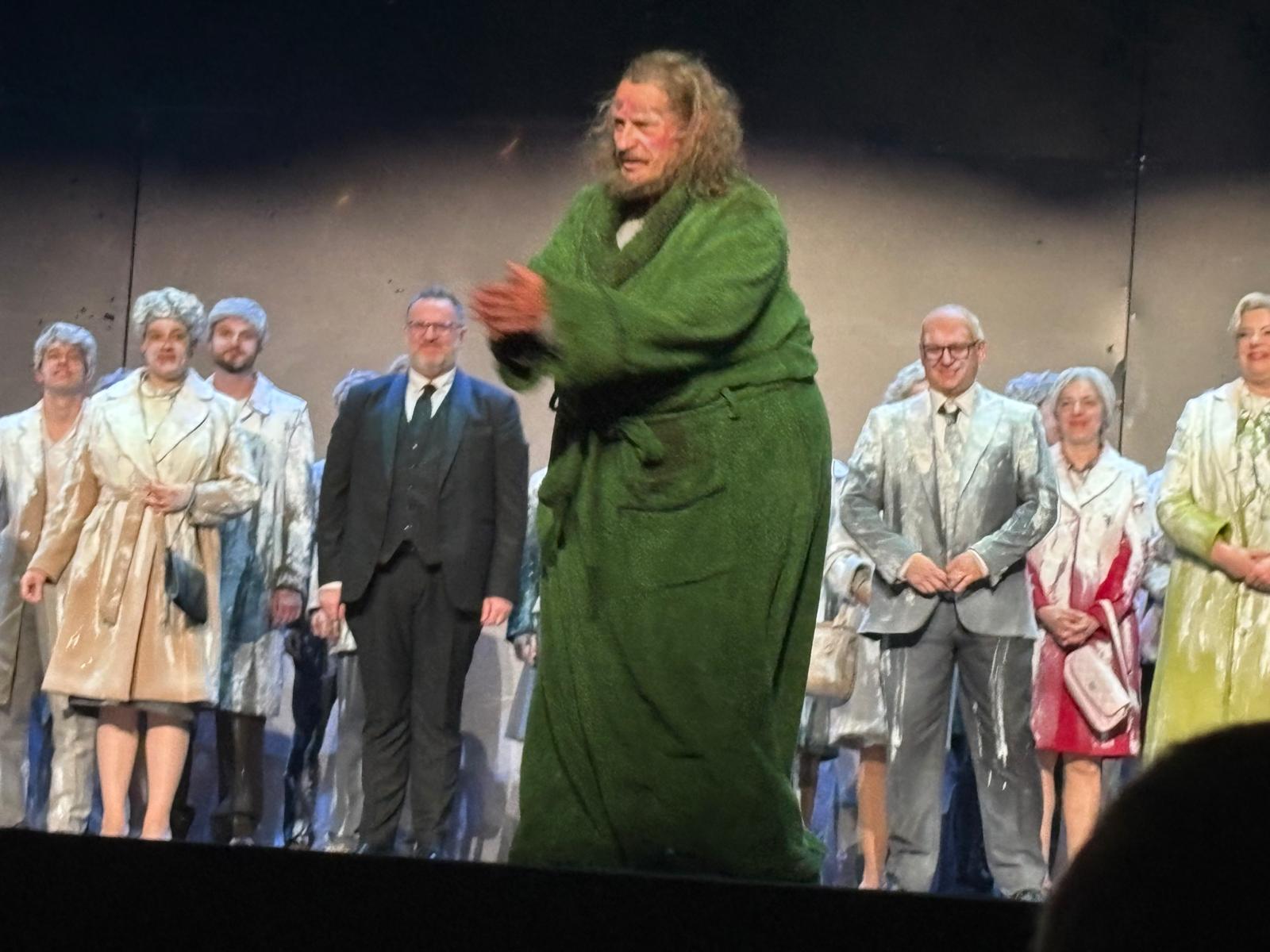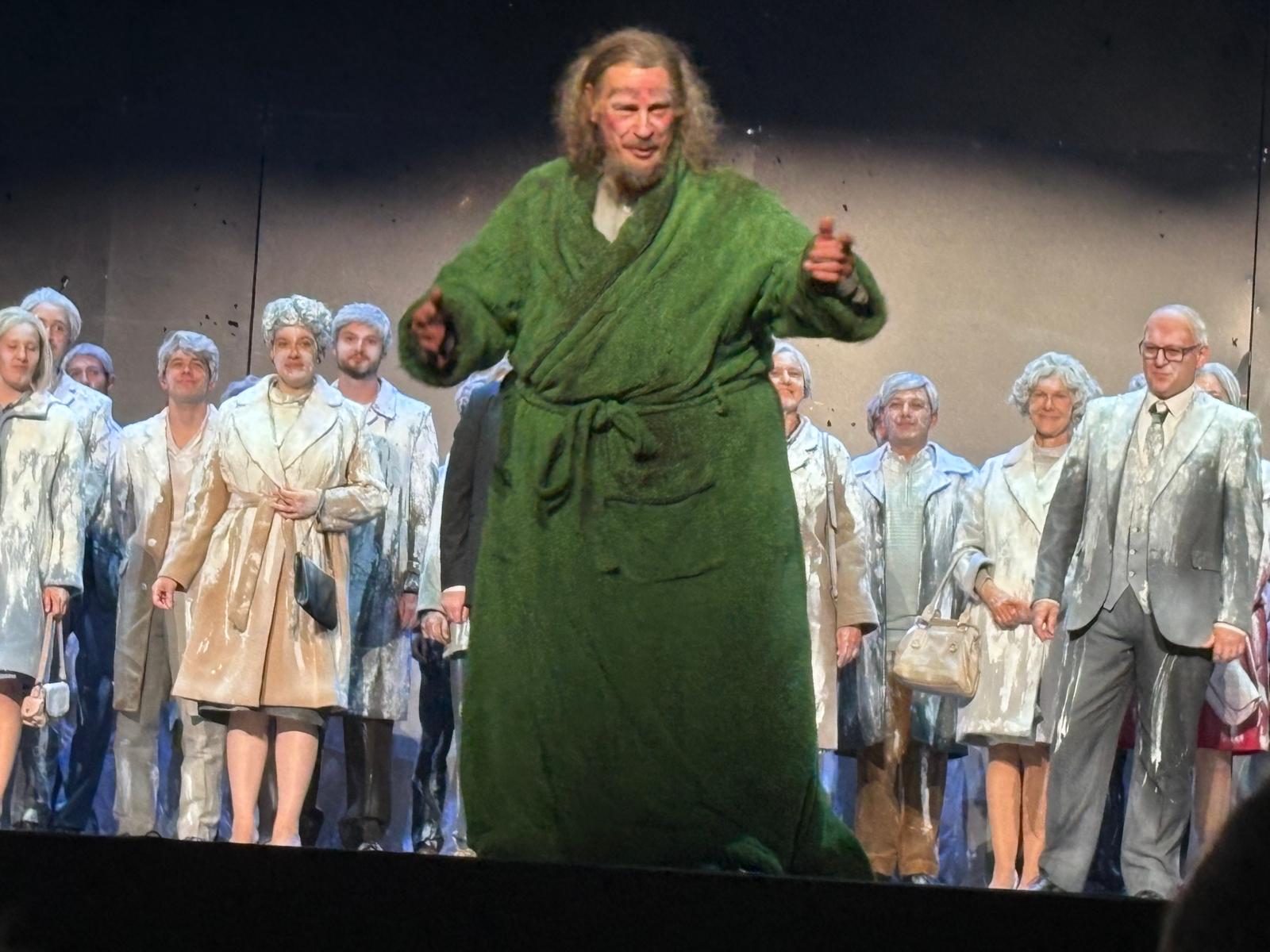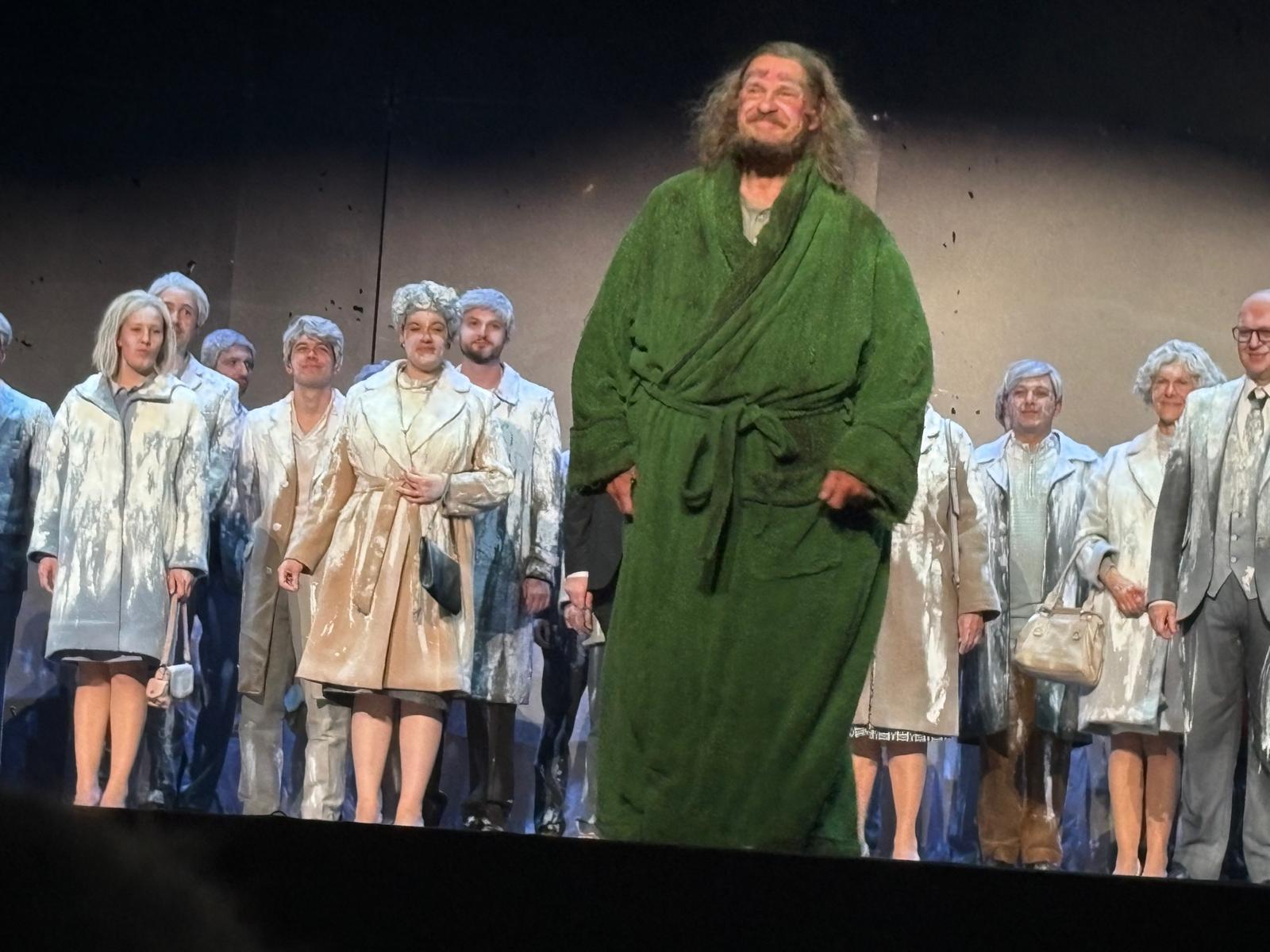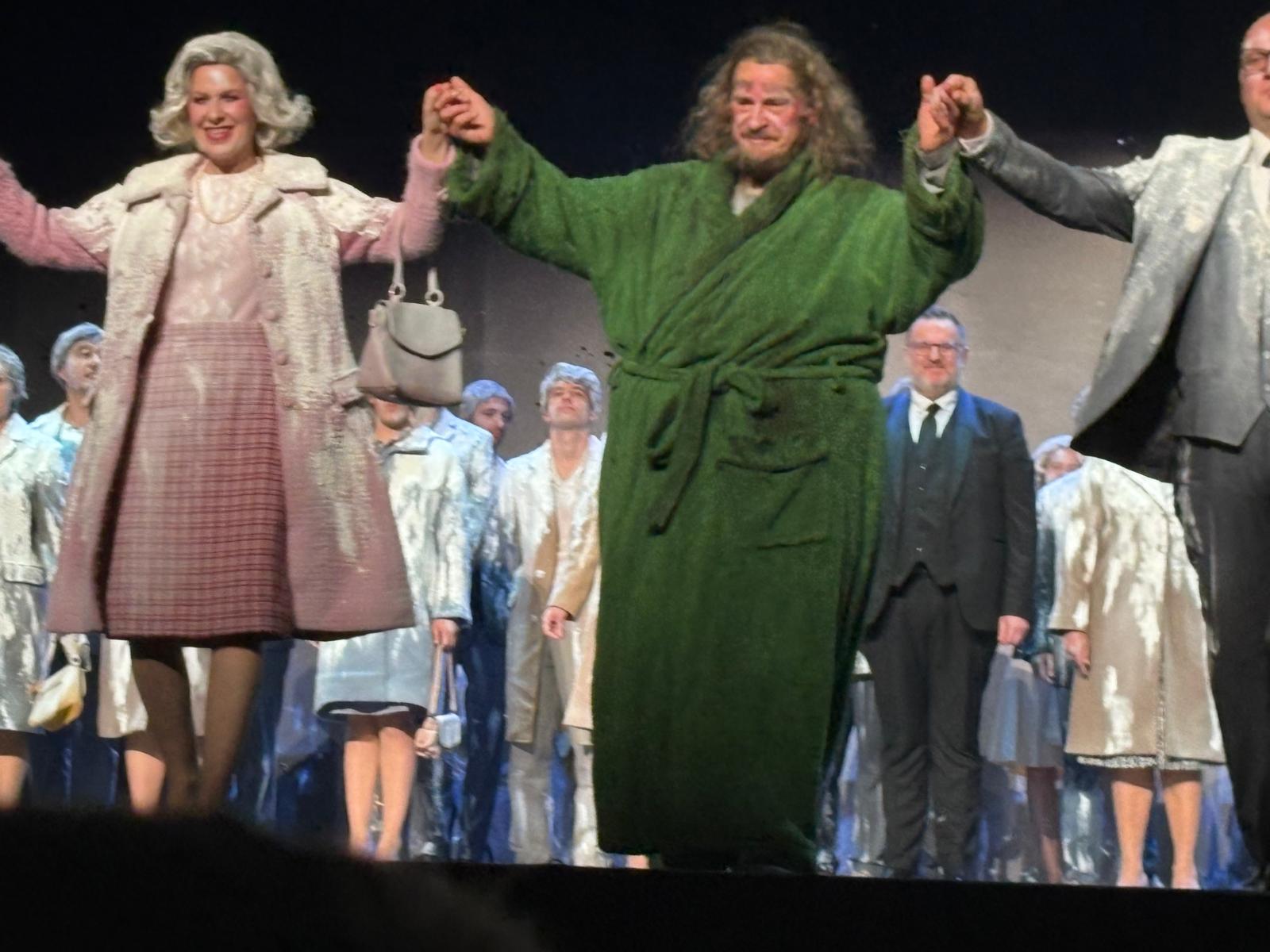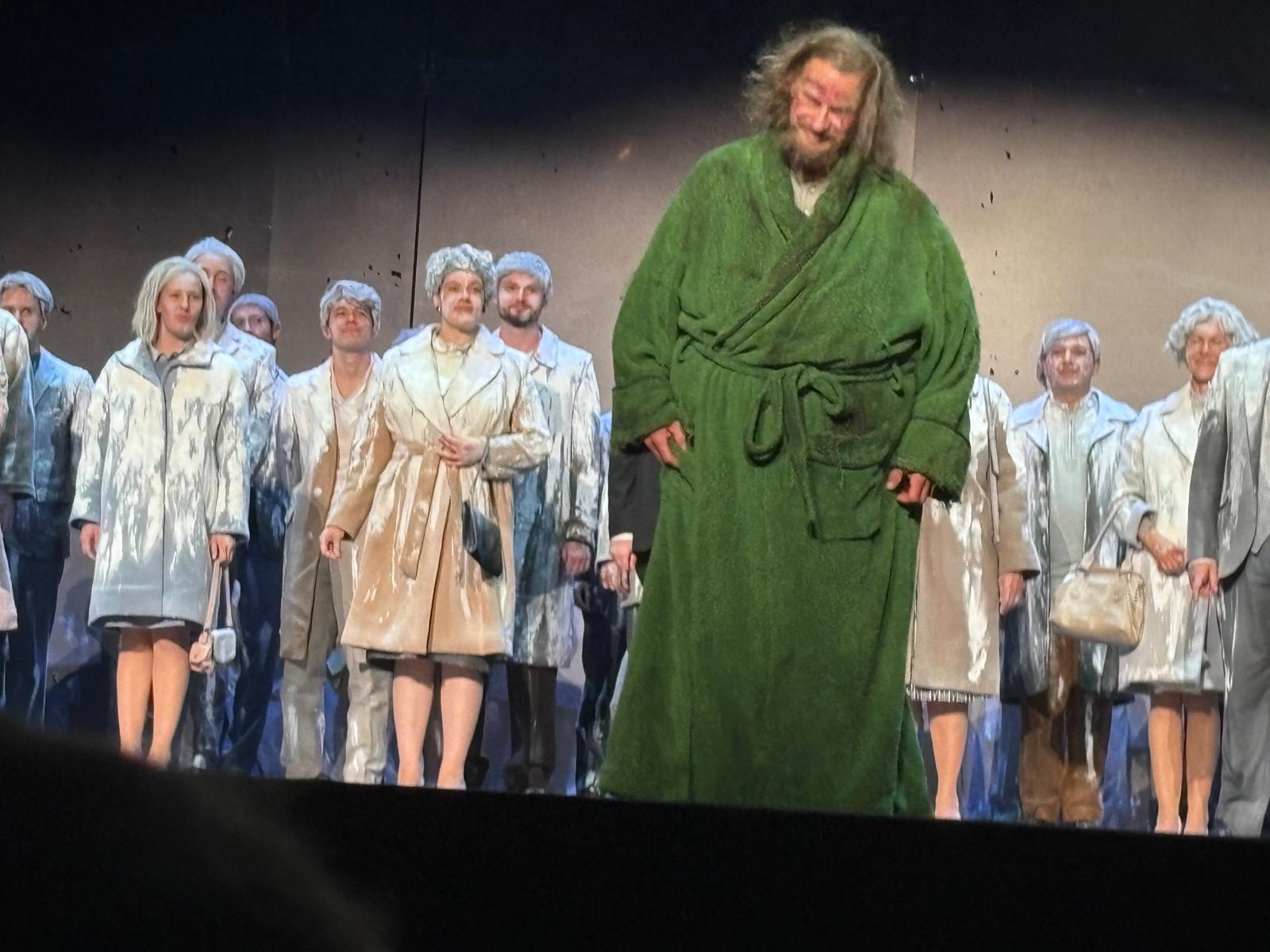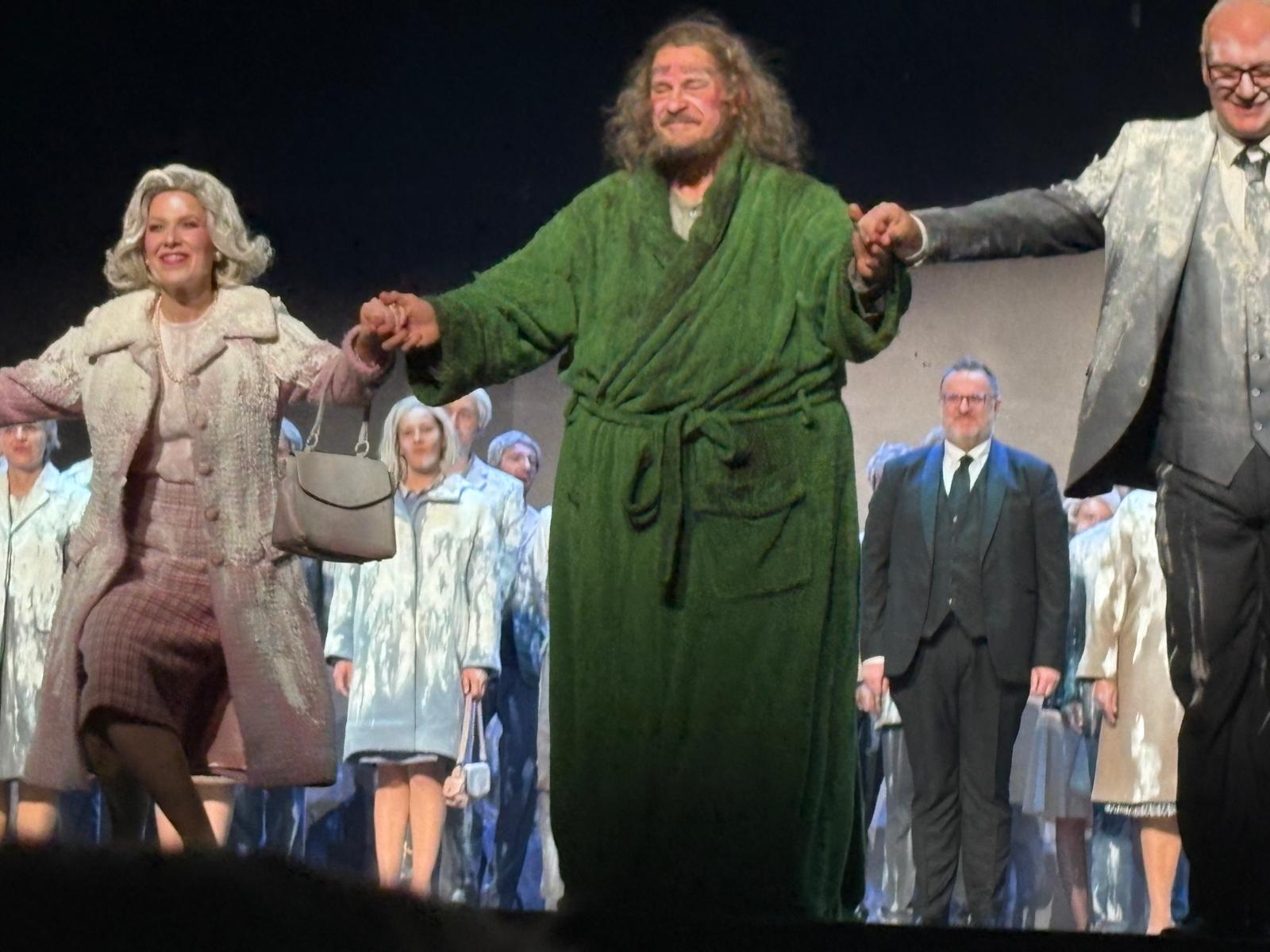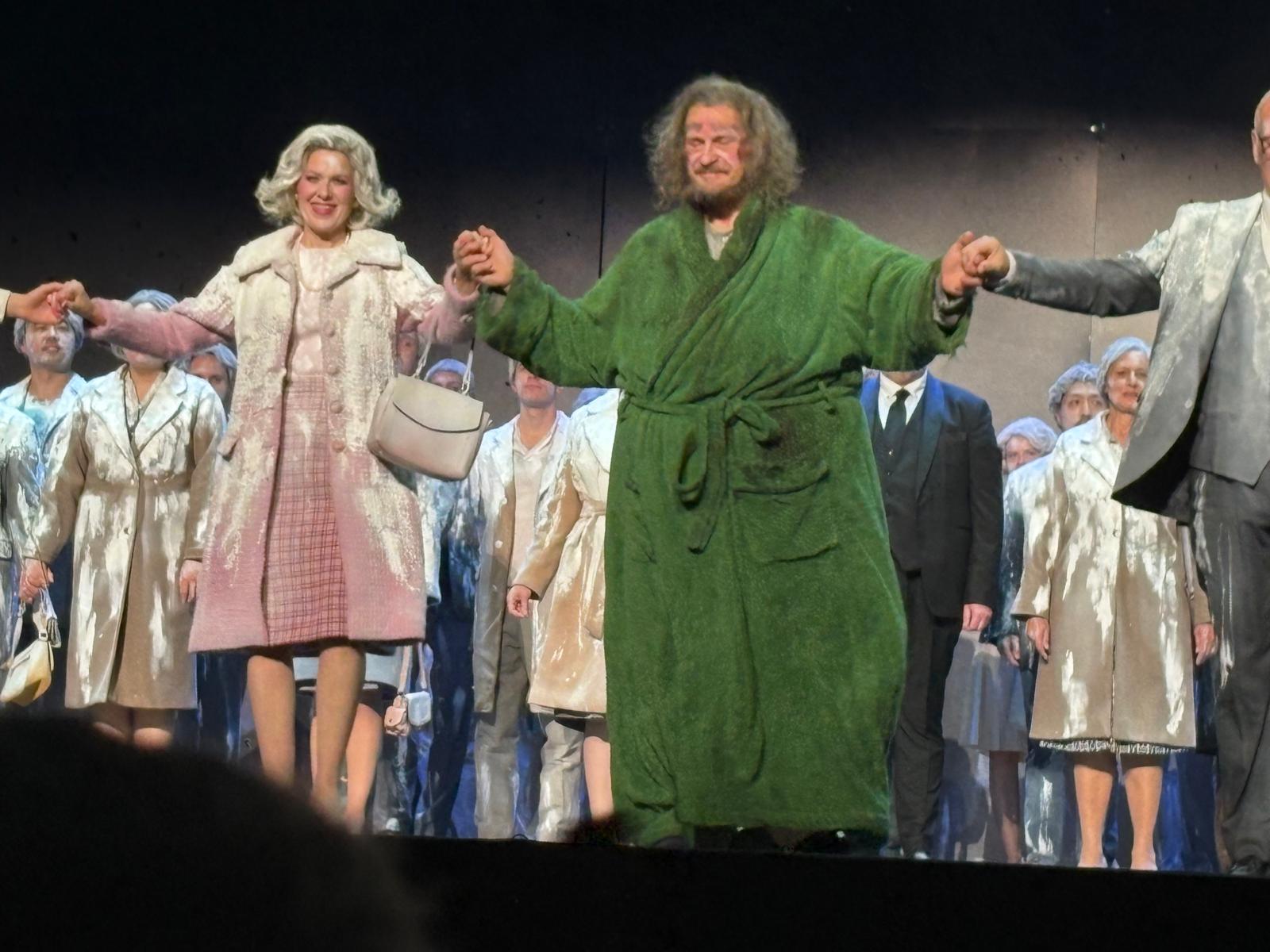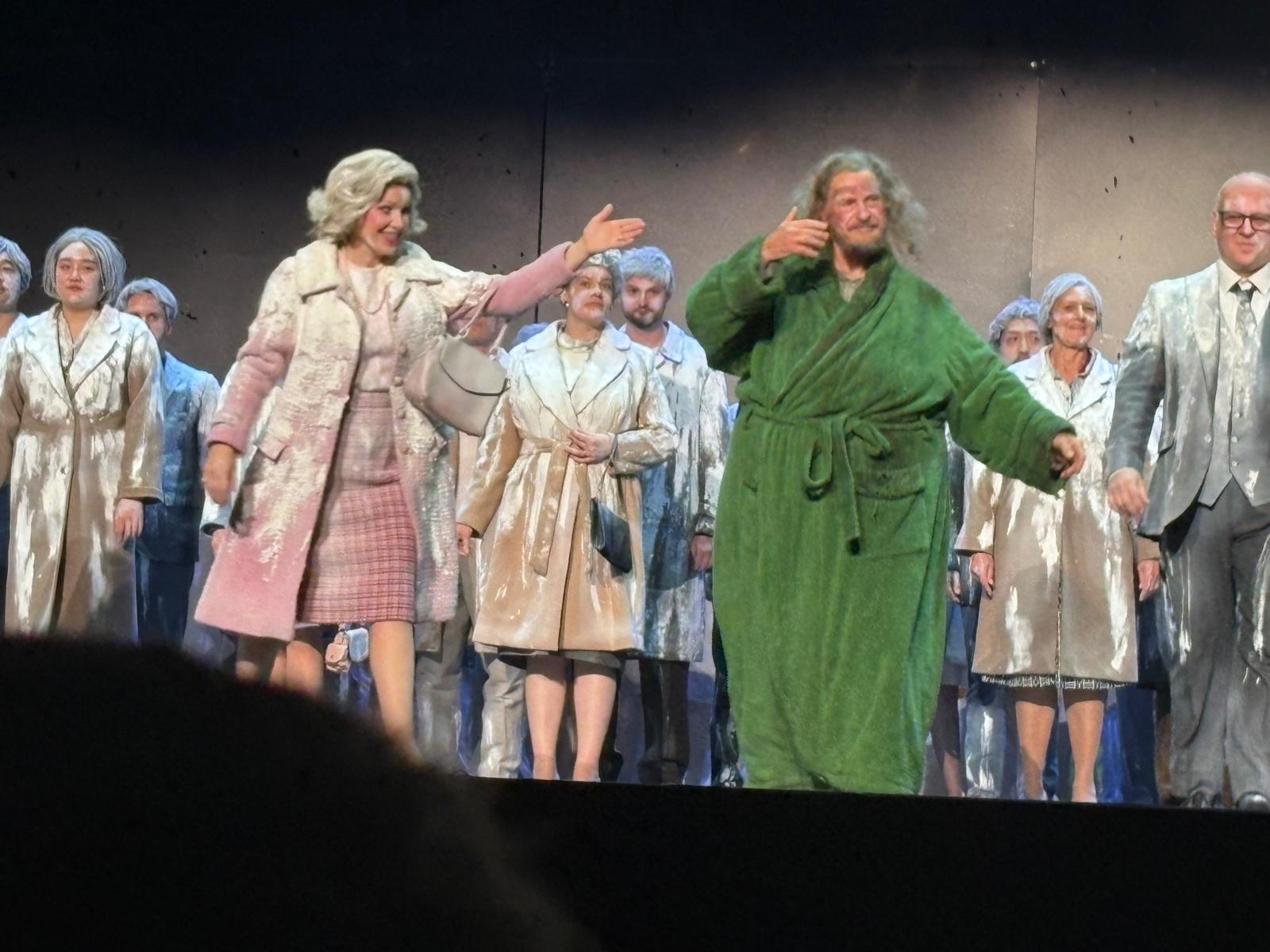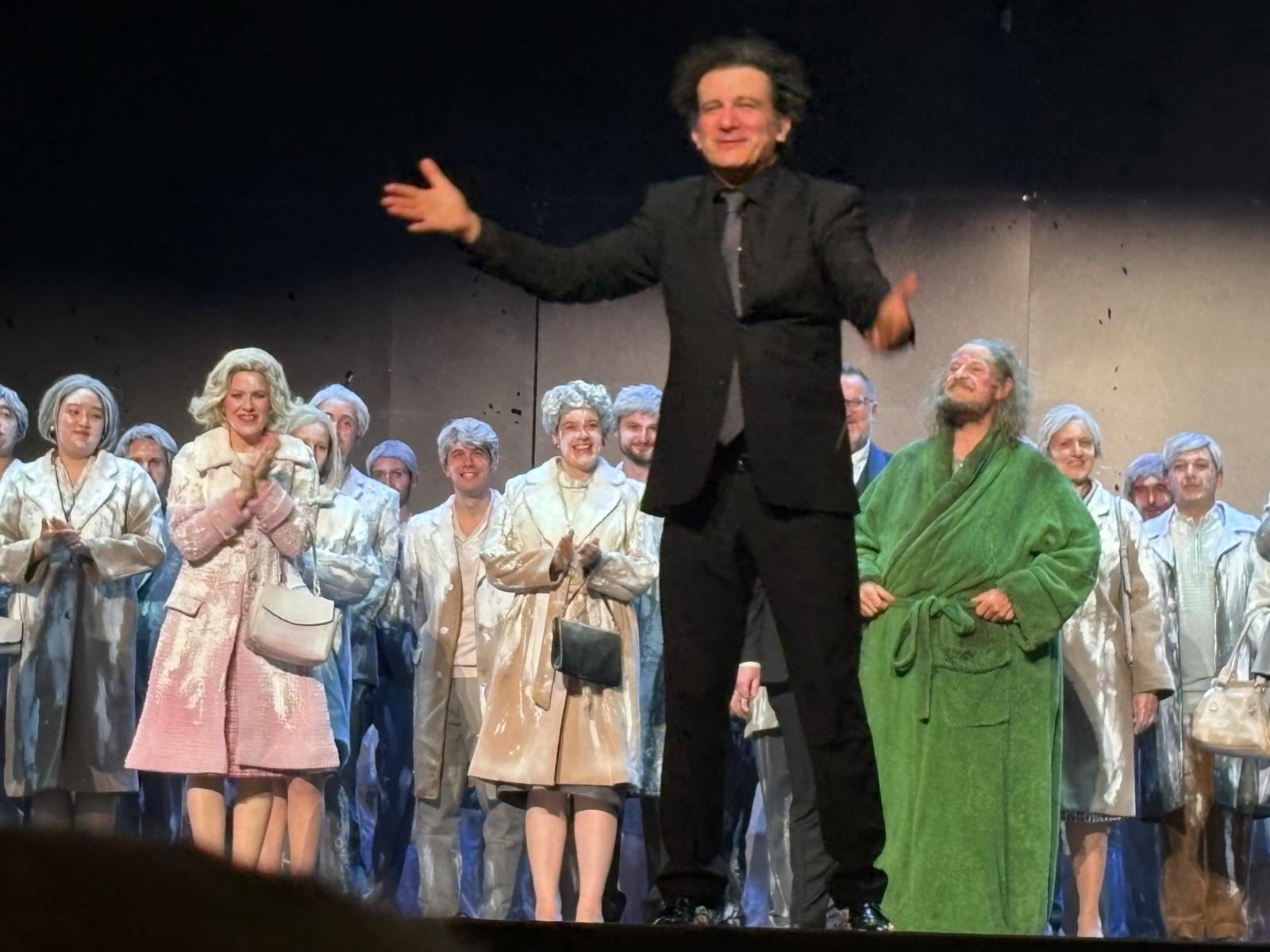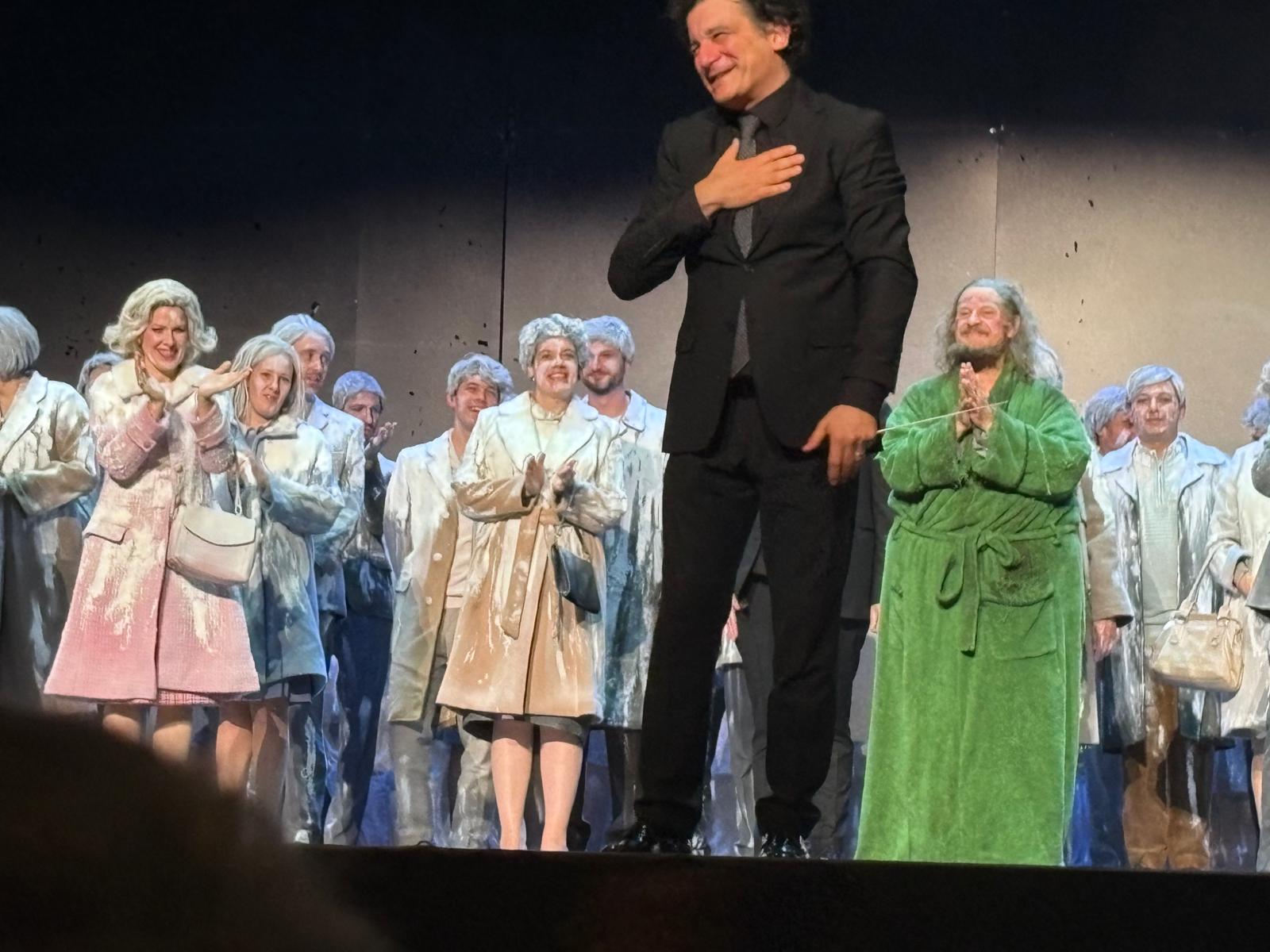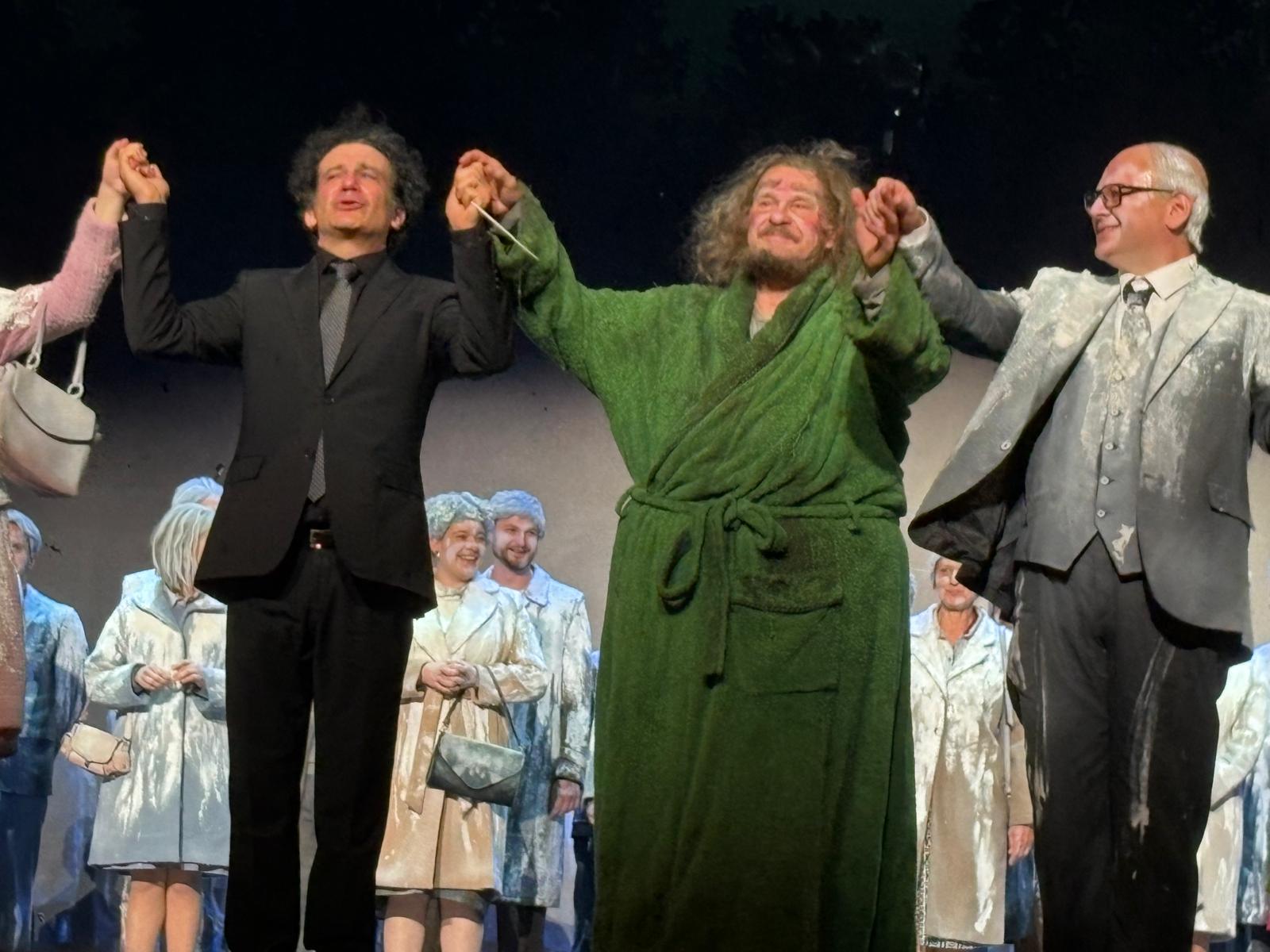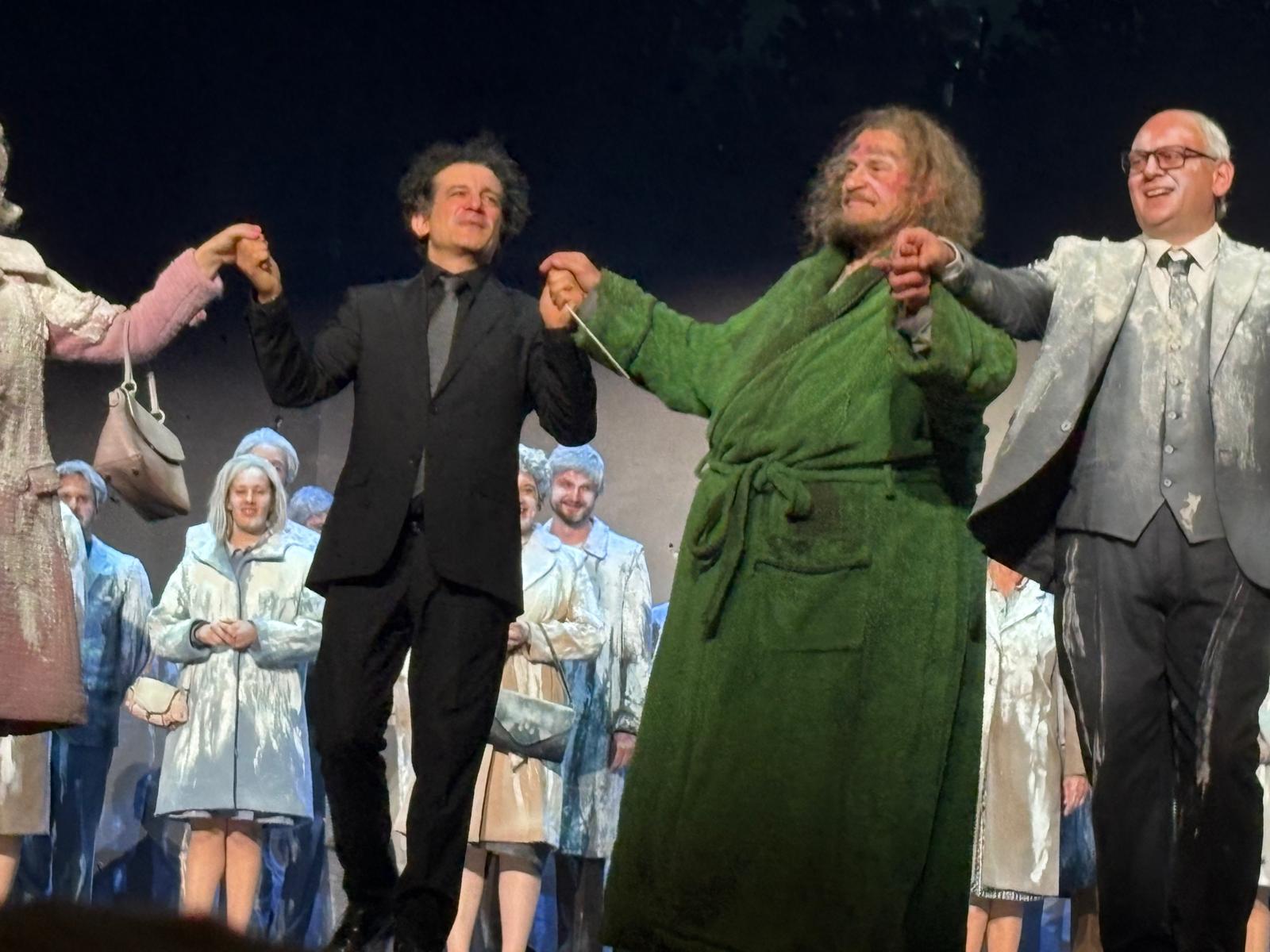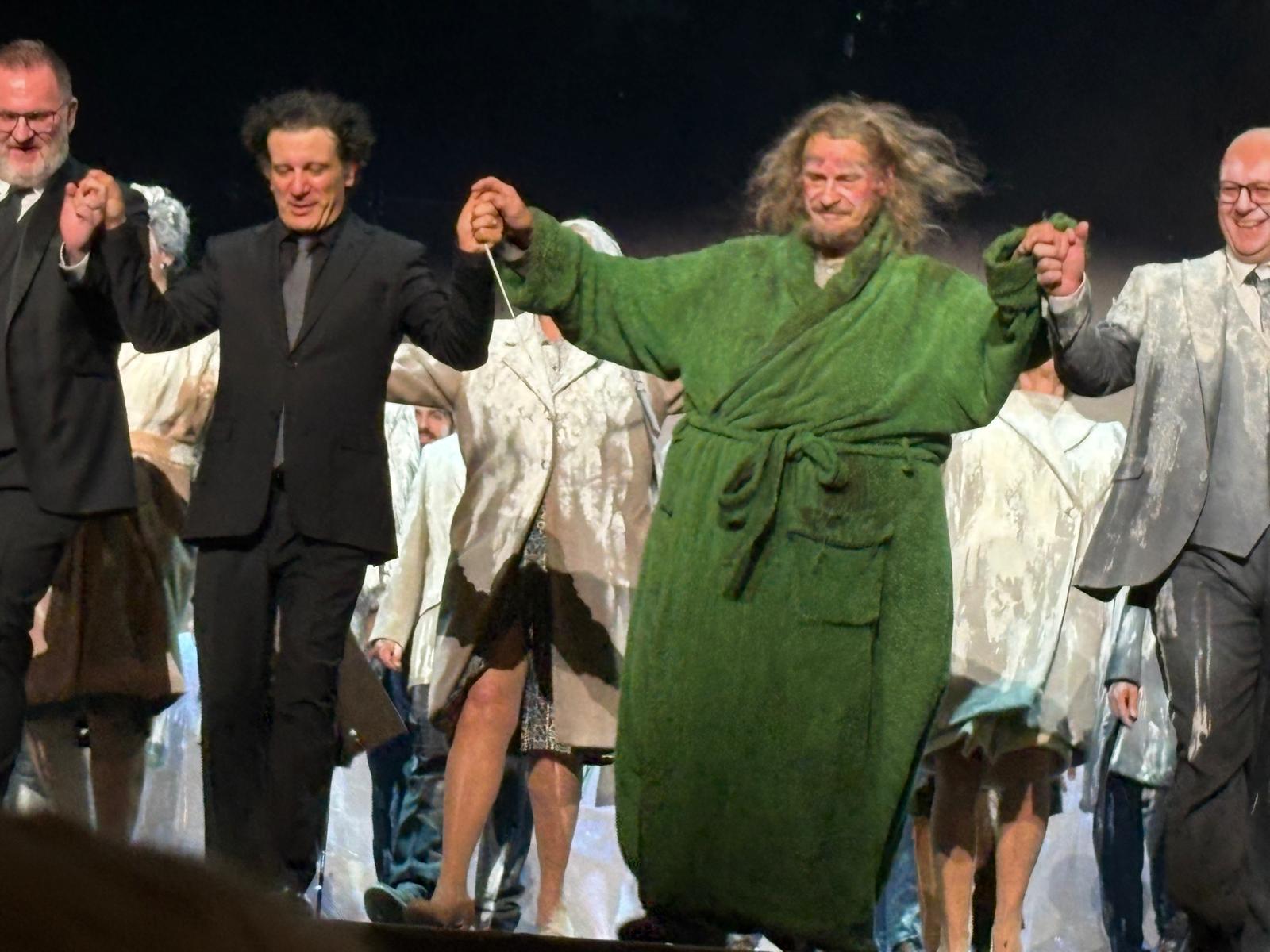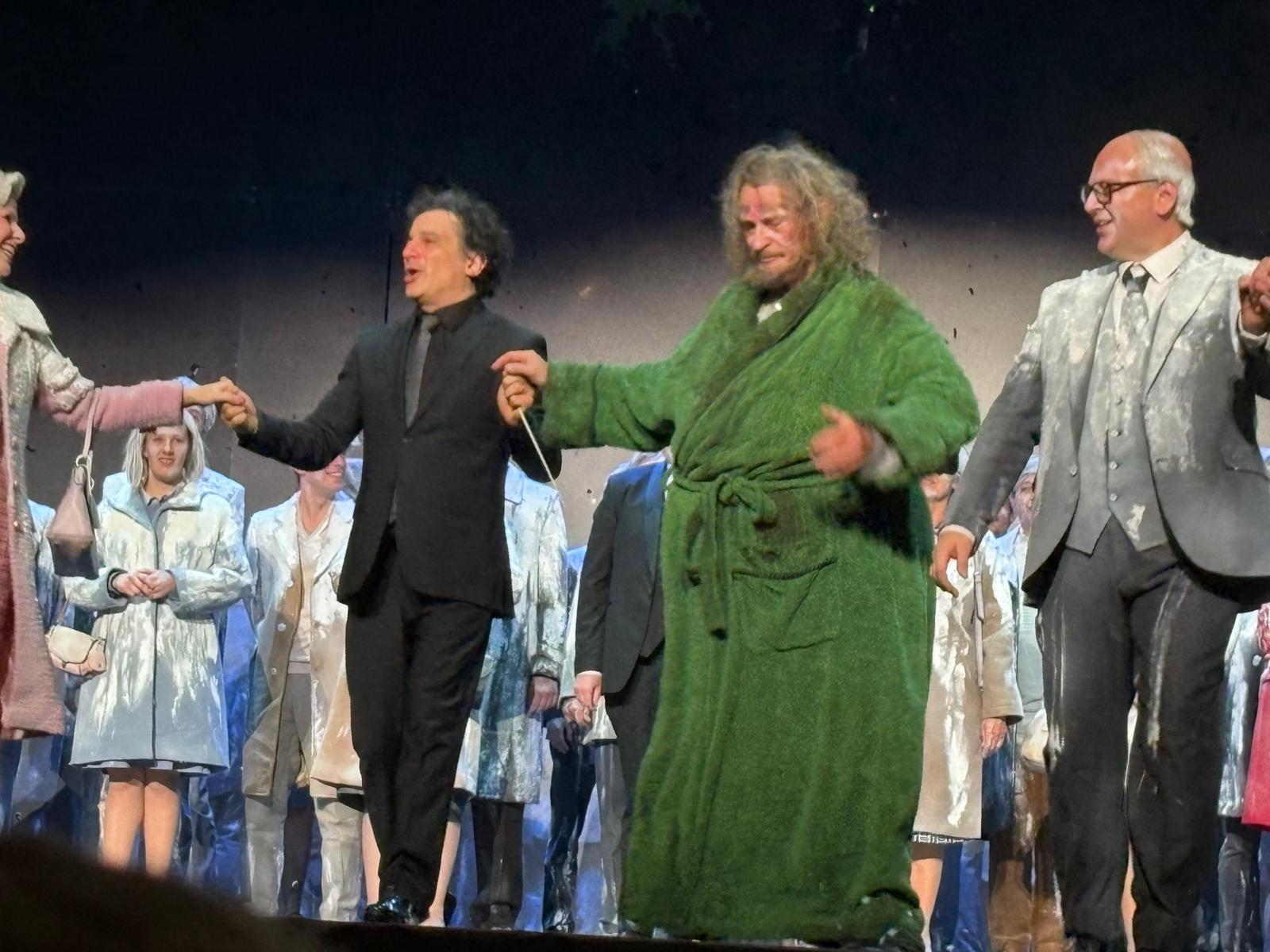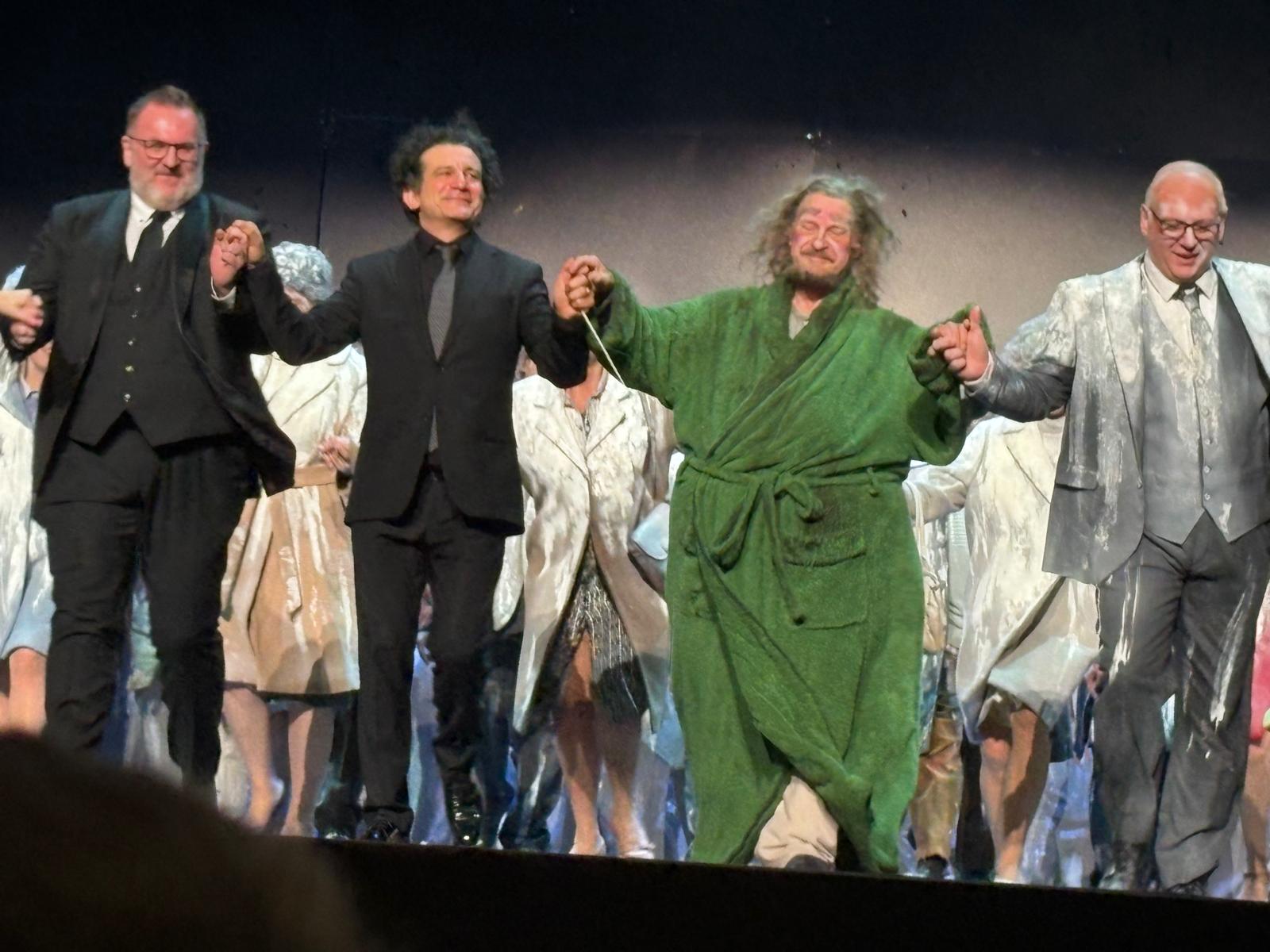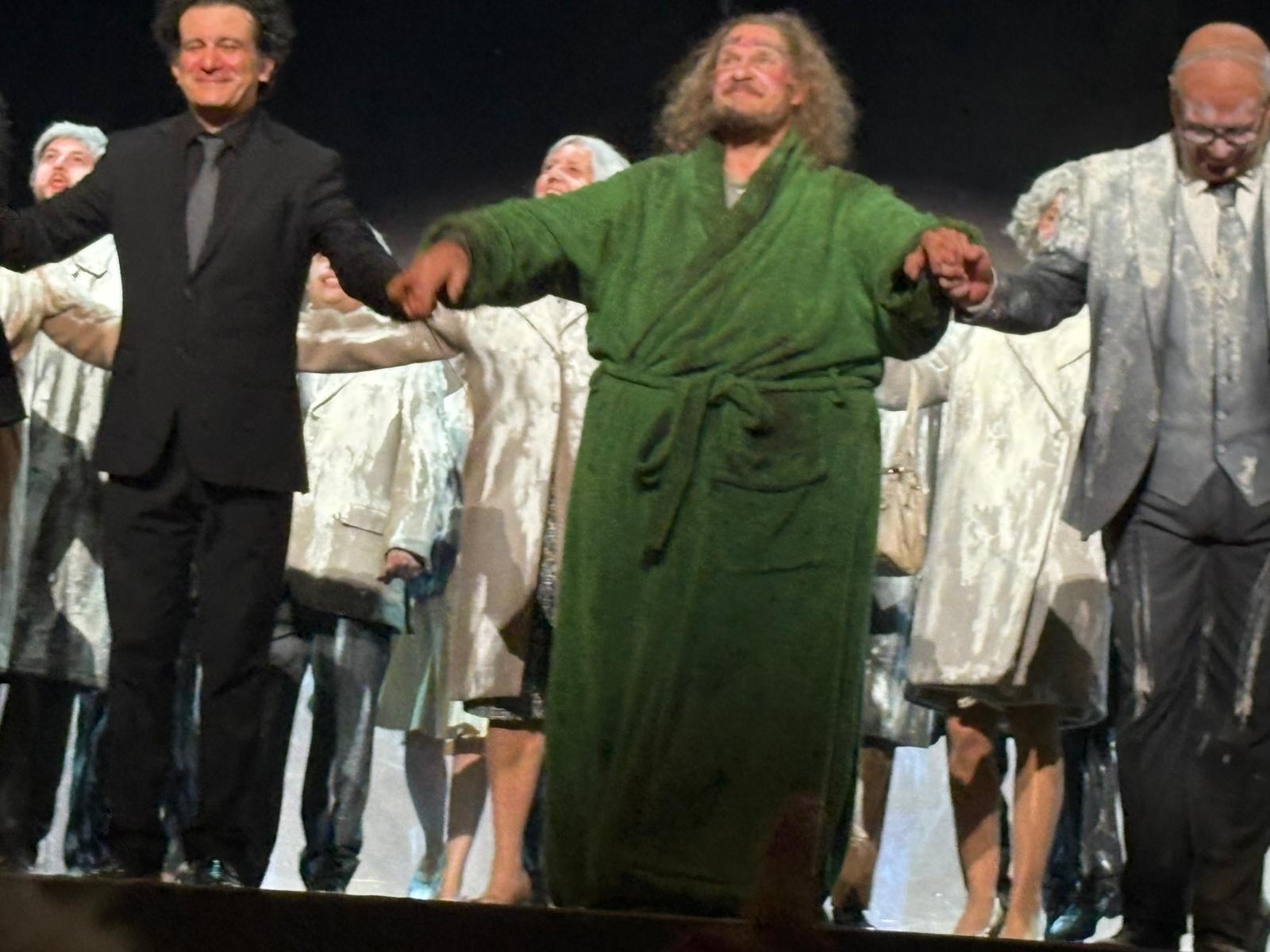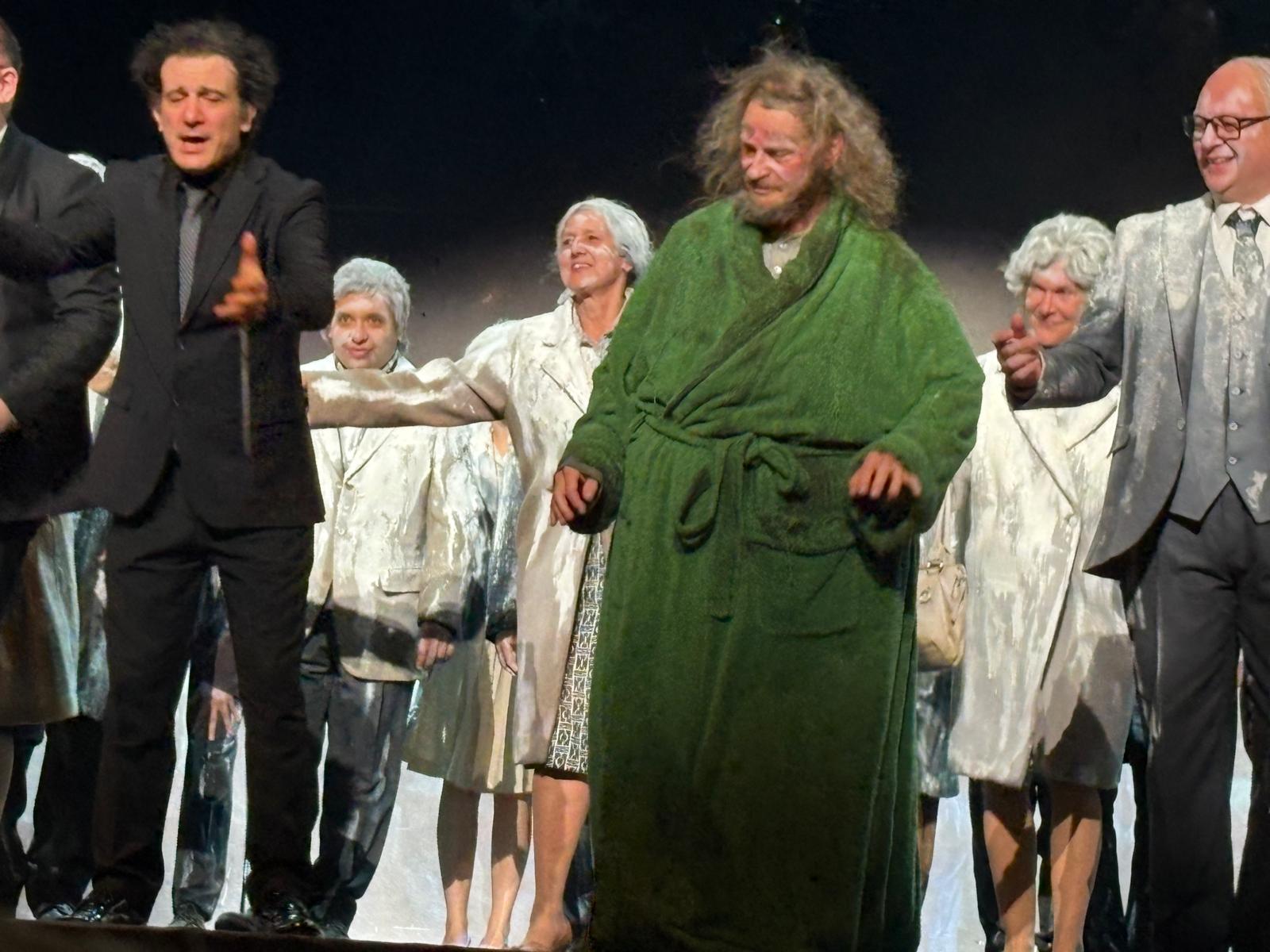La Monnaie/De Munt, Brussels
|
21 September 2025 |
24 September 2025 |
26 September 2025 |
28 September 2025 |
30 September 2025 |
2 October 2025 |
4 October 2025 |
7 October 2025 |
9 October 2025 |
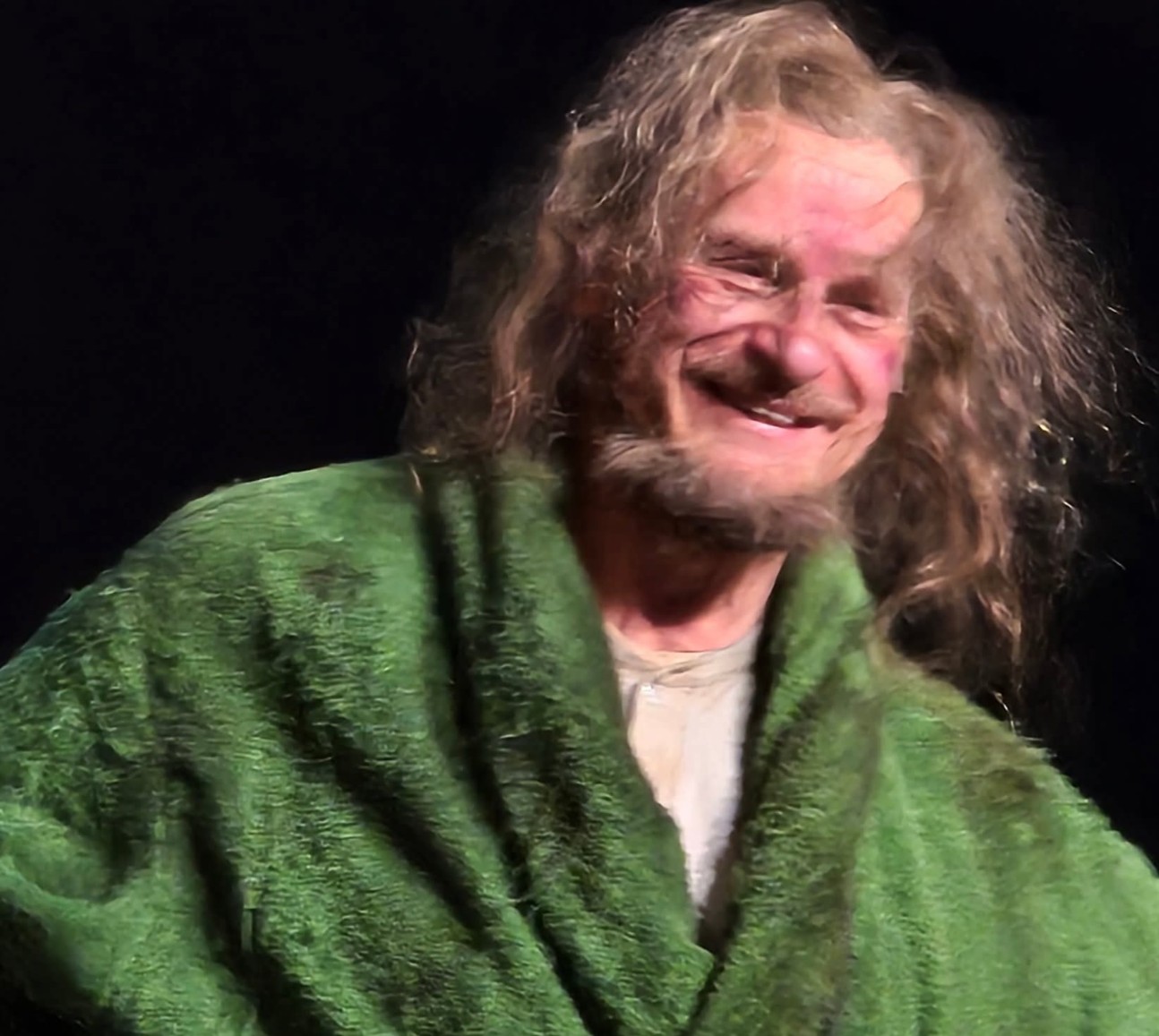
21 September 2025
Composer : Giuseppe Verdi
Director & Costume Designer : Laurent Pelly
Set Designer : Barbara De Limburg
Lighting Designer : Joël Adam
Chorus Master : Emmanuel Trenque
Conductor : Alain Altinoglu / Ouri Bronchti
Orchestra : La Monnaie Symphony Orchestra
Chorus : La Monnaie Chorus
Performers
Falstaff : Simon Keenlyside
Ford : Lionel Lhote
Fenton : Bogdan Volkov
Dr Cajus : John Graham-Hall
Bardolfo : Mikeldi Atxalandabaso
Pistola : Patrick Bolleire
Alice Ford : Sally Matthews
Nannetta : Benedetta Torre
Mrs Quickly : Marvic Monreal
Meg Page : Daniela Barcellona
Simon will make his role debut as Falstaff in Brussels in September 2025.
Click here to see La Monnaie's gallery of Falstaff rehearsal photos
Watch some snippets from Falstaff on this reel from La Monnaie
Falstaff from La Monnaie will be broadcast on Belgian radio station Musiq3 at 19.00 hours local time on Saturday 15 November.
SOUNDBITES
"..En el corazón de esta efervescencia, Sir Simon Keenlyside como Falstaff es simplemente magistral. Mucho más que un simple bufón, encarna al caballero con una humanidad y una inteligencia dramática raras. Su voz de barítono, de una nobleza y una belleza intactas, matiza cada palabra con una expresividad formidable. Es vanidoso, patético, astuto y finalmente filósofo, ofreciendo un retrato de una profundidad y una comicidad inolvidables. Lo rodea un reparto de primer nivel, sin la más mínima debilidad..."
"..At the heart of this effervescence, Sir Simon Keenlyside as Falstaff is simply masterful. Much more than a mere jester, he embodies the knight with rare humanity and dramatic intelligence. His baritone voice, of undimmed nobility and beauty, nuances every word with formidable expressiveness. He is vain, pathetic, cunning, and ultimately philosophical, offering a portrait of unforgettable depth and humor. He is surrounded by a first-class cast, without the slightest weakness."
"Prise de rôle réussie pour Simon Keenlyside
Sir John Falstaff est surnommé « il Pancione » (Le ventru), il fait bombance tous les jours à l’auberge et bon vivant inconséquent et prétentieux, il s’endette et se croit assez malin pour duper les femmes à qui il écrira des lettres ridicules pour les séduire. Autant dire qu’on est très loin du style « à la ville », so chic et so british, du baryton Sir Simon Keenlyside que l’on a tant aimé dans ses rôles de dandy élégant, tel Don Giovanni. Mais sur la scène, tout est possible. Et littéralement métamorphosé, Keenlyside joue parfaitement le jeu du bouffon ridiculisé, affublé d’un ventre qui parait « naturel » et habillé d’amples vêtements, il donne le change par une faconde qu’on ne lui connaissait pas et qui fait mouche.
Le timbre est toujours aussi somptueux dans la salle à l’acoustique parfaite de La Monnaie, son entente avec l’orchestre et l’énergique battue d’Altinoglu, absolument parfaite comme son jeu, sans outrance, mais avec ce qu’il faut de comique. Dès la scène de l’auberge qui le met aux prises avec deux ténors, le Docteur Cajus (John Graham-Hall) et Bardoflo (Mikeldi Atxalandabaso), sa belle voix de baryton aux graves solides, éclate sur la scène avec la puissance et l’autorité d’un personnage sûr de lui et de son pouvoir.
Mais les qualités vocales et théâtrales qui ont propulsé Simon Keenlyside parmi les meilleurs barytons, lui permettent de donner une lecture originale du personnage, où derrière l’épaisseur physique et la grossièreté des propos, se cachent aussi les fêlures de celui qui voudrait plaire malgré le caractère repoussant de son aspect extérieur. Usant aussi bien de sa puissance vocale que de son sens des nuances, de sa capacité à alléger son timbre ou à pratiquer la voix mixte dans des aigus souverains, Keenlyside nous surprend et nous séduit, donnant à son personnage de bouffon finalement trompé et cruellement moqué, une dimension humaine qui nous touche profondément."
"A successful role debut for Simon Keenlyside
Sir John Falstaff is nicknamed "il Pancione" (The Pot-bellied One). He feasts every day at the inn, and, as an inconsistent and pretentious bon vivant, he gets into debt and believes himself clever enough to dupe women, writing ridiculous letters to seduce them. Suffice it to say, this is a far cry from the "urban" style, so chic and so British, of the baritone Sir Simon Keenlyside, whom we so loved in his roles as elegant dandies, such as Don Giovanni. But on stage, anything is possible. And literally transformed, Keenlyside perfectly plays the role of the ridiculed jester, adorned with a seemingly "natural" belly and dressed in loose-fitting clothes. He deceives the audience with an unfamiliar eloquence that hits the mark.
The timbre is as sumptuous as ever in the acoustically perfect hall of La Monnaie, its harmony with the orchestra and Altinoglu's energetic drumming, absolutely perfect, like his playing, without excess, but with just the right amount of comedy. From the inn scene where he confronts two tenors, Doctor Cajus (John Graham-Hall) and Bardoflo (Mikeldi Atxalandabaso), his beautiful baritone voice with its solid bass bursts onto the stage with the power and authority of a character confident in himself and his power.
But the vocal and theatrical qualities that have propelled Simon Keenlyside among the best baritones allow him to give an original interpretation of the character, where behind the physical depth and coarseness of his words also lie the flaws of a man who strives to please despite his repulsive exterior. Using both his vocal power and his sense of nuance, his ability to lighten his timbre or to practice mixed voice in sovereign high notes, Keenlyside surprises and seduces us, giving his character of a buffoon who is ultimately deceived and cruelly mocked, a human dimension which touches us deeply."
"..On n’associe peut-être pas spontanément le nom de Simon Keenlyside au répertoire italien en général, et verdien en particulier. Montano, Germont, Posa, Ford, Rigoletto, Macbeth,… Le baryton britannique a pourtant régulièrement chanté Verdi, et après Ford, le voici qui affronte ici le héros éponyme du dernier opéra du maître de Busseto. Après quelque quarante années au service de l’art lyrique, Simon Keenlyside reste très présent sur les scènes d’opéras (outre Falstaff, il sera prochainement Bottom du Songe d’une nuit d’été à Madrid, Wozzeck à Berlin, ou encore Golaud à Vienne, Milan et Berlin. De fait, la voix du baryton a conservé toutes ses qualités en termes de beauté, de nuances (superbe « Alfin t’ho colto, raggiante fior » ) et de puissance, et le phrasé est constamment soigné. C’est in fine un portrait très complet de Sir John que délivre Simon Keenlyside, qui n’en néglige aucune facette : le ridicule bien sûr, l’arrogance insupportable, mais aussi le côté pitoyable d’un vieil homme à qui l’on rappelle cruellement qu’il n’a plus grand chose à attendre de la vie. Une prestation accueillie avec enthousiasme par un public visiblement ravi de la représentation !"
"..The name Simon Keenlyside may not be immediately associated with the Italian repertoire in general, and Verdi in particular. Montano, Germont, Posa, Ford, Rigoletto, Macbeth, etc. The British baritone has, however, regularly sung Verdi, and after Ford, here he is taking on the eponymous hero of the last opera by the master of Busseto. After some forty years of service to lyric art, Simon Keenlyside remains very present on the opera stage (in addition to Falstaff, he will soon be Bottom in A Midsummer Night's Dream in Madrid, Wozzeck in Berlin, and Golaud in Vienna, Milan and Berlin). In fact, the baritone's voice has retained all its qualities in terms of beauty, nuance (superb "Alfin t'ho colto, raggiante fior") and power, and the phrasing is constantly polished. In the end, Simon Keenlyside delivers a very complete portrait of Sir John, neglecting no facet: the ridiculous of course, the unbearable arrogance, but also the pitiful side of an old man who is cruelly reminded that he no longer has much to expect from life. A performance enthusiastically received by an audience visibly delighted with the performance!"
"..La distribution vocale se distingue par son équilibre, les voix masculines formant un ensemble robuste et cohérent tandis que les voix féminines brillent par une homogénéité lumineuse. Chacun des solistes y trouve un espace singulier, à commencer par Sir Simon Keenlyside, qui prête à Falstaff une voix pleine et autoritaire, capable de bourrades vigoureuses comme de poussées marquant l’usure du temps. Cette vivacité riche en contrastes confère au chevalier une humanité attachante et une grandeur magnanime, en parfaite adéquation avec le rôle..."
"..The vocal cast is distinguished by its balance, the male voices forming a robust and coherent ensemble while the female voices shine with a luminous homogeneity. Each of the soloists finds a singular space, starting with Sir Simon Keenlyside, who lends Falstaff a full and authoritative voice, capable of vigorous slaps as well as thrusts marking the wear of time. This liveliness, rich in contrasts, gives the knight an endearing humanity and a magnanimous grandeur, perfectly suited to the role..."
"..La distribution rassemble plusieurs artistes habitués de La Monnaie. Sir Simon Keenlyside, baryton britannique, revient à La Monnaie, 22 ans après son Don Giovanni, dernier rôle qu’il a chanté à Bruxelles. Il présente son premier Falstaff, "un Falstaff un peu triste, un peu attendrissant", différent des versions plus flamboyantes habituelles."
"..The cast brings together several regulars at La Monnaie. Sir Simon Keenlyside, a British baritone, returns to La Monnaie, 22 years after his Don Giovanni, the last role he sang in Brussels. He presents his first Falstaff, "a Falstaff that's a little sad, a little touching," a departure from the usual more flamboyant versions."
".. Pour sa prise de rôle, le baryton anglais Sir Simon Keenlyside campe un Falstaff pantagruélique, dont la voix ample impose le personnage avec une évidence généreuse et un phrasé éloquent."
"..For his first portrayal of the role, the English baritone Sir Simon Keenlyside plays a gargantuan Falstaff, whose ample voice imposes the character with generous clarity and eloquent phrasing."
"..Après l’union du jeune couple et le dur retour à la réalité d’un Falstaff qui se sait à présent bien moins irrésistible qu’il ne le croyait, l’œuvre s’achève dans la bonne humeur sur la célèbre fugue « Tutto nel mondo è burla » entonnée par un Sir John Falstaff qu’aura incarné à la perfection un Sir Simon Keenlyside capable de rendre toutes les facettes d’un personnage à la fois ridicule et vaniteux, mais aussi rusé, pitoyable et attachant, bien plus humain que bouffon."
"..After the union of the young couple and the hard return to reality of a Falstaff who now knows he is much less irresistible than he thought, the work ends in good humour with the famous fugue "Tutto nel mondo è burla" sung by a Sir John Falstaff who will have been perfectly embodied by Sir Simon Keenlyside, capable of rendering all the facets of a character who is at once ridiculous and vain, but also cunning, pitiful and endearing, much more human than buffoon."
"..Quant à Simon Keenlyside, il est permis de regretter que sa voix ait un peu perdu de cette fêlure, de cet émail légèrement ébreché, qui la rendait immédiatement reconnaissable. Mais s’il a moins à offrir en terme de personnalité vocale, il n’a rien lâché en termes de maîtrise et d’endurance, et le style est toujours aussi châtié. C’est donc logiquement qu’il nous offre un « pancione » touchant davantage que grotesque, qui nous ferait presque croire qu’il a vraiment été irrésistible à l’époque où il était page du Duc de Norfolk. Même aux moments les plus désopilants, la rigueur ne perd pas ses droits, et le baryton parvient à rappeler tout ce que l’écriture de Verdi doit au bel canto."
"..As for Simon Keenlyside, it is permissible to regret that his voice has lost a little of that crack, that slightly chipped enamel, which made it immediately recognizable. But if he has less to offer in terms of vocal personality, he has given up nothing in terms of control and endurance, and the style is still as refined. It is therefore logical that he offers us a "pancione" that is touching rather than grotesque, which almost makes us believe that he was truly irresistible during his time as page to the Duke of Norfolk. Even at the most hilarious moments, rigour does not lose its rights, and the baritone manages to recall all that Verdi's writing owes to bel canto."
"..Simon Keenlyside, jadis Ford d'envergure, assure une prise de rôle parfaite et en exacte connexion avec la mise en scène de Pelly. Sa noblesse vocale et son jeu d'acteur se veulent vindicatifs dans la fameuse tirade L'Onore? Ladri! du premier acte, mais la voix se fait mielleuse et veule, nimbée de vraie-fausse prétention, lors de son entrevue avec le sieur Fontana. Il souligne la dignité blessée et la mélancolie de l'antihéros, au lever de rideau du troisième acte, les pieds dans une improbable bassine, affublé d'un peignoir délavé du plus bel effet. Irrésistiblement comique au gré du final de l'acte II ou de la scène de la Forêt, Keenlyside peut aussi, par la noblesse de son art vocal, inspirer respect et pitié lors de son réel et ultime repentir."
"..Simon Keenlyside, once a Ford of stature, delivers a perfect performance in the role, in exact harmony with Pelly's production. His vocal nobility and acting are intended to be vindictive in the famous tirade "L'Onore? Ladri!" in the first act, but his voice becomes cloying and weak, shrouded in true-false pretension, during his interview with Mr. Fontana. He underlines the wounded dignity and melancholy of the antihero, at the curtain rise of the third act, his feet in an improbable basin, dressed in a faded dressing gown with the most beautiful effect. Irresistibly comic in the finale of Act II or the scene in the Forest, Keenlyside can also, through the nobility of his vocal art, inspire respect and pity during his real and final repentance."
"..Pero el as en la manga era la primera vez de Sir Simon Keenlyside en su aproximación al protagonista, por el que ha dejado su óptimo Ford tan frecuentado. Y como suele suceder entre pares, el gran Keenlyside ha hecho honor al inmenso Falstaff. Con un apéndice notable para simular obesidad (menos mal) fue irascible, presuntuoso, despectivo, asustadizo, rencoroso, incorregible y adorable. No todo fue su formidable carisma escénico, sus gestos, su forma de acentuar y hasta paladear el texto (un gracias especial a Boito). Cantó también como el señor del canto que siempre ha sido sin forzar, siguiendo algunas medias voces y falsetes de la tradición (que vienen seguramente desde el estreno de la obra), con un buen agudo y un centro y grave ahora más oscuros. Como en toda caracterización completa no tiene sentido elegir un momento, pero, además de su actuación en todo el último cuadro (no me refiero sólo a esa insólita y colosal fuga final aunque ‘la risata final’ parece ser la suya) tendría que señalar su maestría en el monólogo que abre el mismo acto."
"..But the ace up his sleeve was Sir Simon Keenlyside's first approach to the protagonist, for whom he has left his much-frequented, excellent Ford. And as is often the case among peers, the great Keenlyside lived up to the immense Falstaff. With a notable appendage to simulate obesity (thank goodness), he was irascible, presumptuous, contemptuous, fearful, spiteful, incorrigible, and adorable. It wasn't all about his formidable stage charisma, his gestures, his way of accentuating and even savouring the text (a special thanks to Boito). He also sang like the master of song he has always been, without forcing it, following some traditional half-voices and falsettos (surely dating back to the play's premiere), with a good high note and a now darker middle and low note. As in any complete characterization, it makes no sense to choose a moment, but, in addition to his performance throughout the last scene (I am not referring only to that unusual and colossal final fugue, although 'the final laugh' seems to be his), I would have to point out his mastery in the monologue that opens the same act."
All translations by Google Translate
English translation of German text by SK Info
"Falstaff, as Shakespeare and Verdi probably had in mind, was brought to life by a barely recognizable Simon Keenlyside in his role debut in Brussels.
... On stage was a luxurious ensemble that impressed above all with its thoroughly homogeneous performance. Simon Keenlyside, an accomplished Ford, also sang his first Falstaff here. He is also likely to be considered for the title role in the future. His velvety timbre, which lacked neither bite nor substance, suits the role well. Keenlyside shone with his eloquent command of the text, eloquent parlando, and powerful delivery, using his bright-timbre baritone to express both the burlesque side of the old knight and the melancholy of the character. ..."
"..Simon Keenlyside, singing his first Falstaff, embodied the role with effortless brilliance,his resonant, rounded voice and natural authority giving the character both warmth and depth. We believed in him instantly.."
"...Falstaffs Bauch wird nicht nur behauptet. In aller Immensität quillt er Simon Keenlyside über den Gürtel. Der hockt in einer gemütlich heruntergekommenen Bar , ungefähr in den 1969er Jahren, und schmiedet Pläne, wie er sein Shilling- und Fraueneroberungskonto aufbessern könnte. ...Keenlyside singt den dicken Ritter einnehmend leggerio, hell timbriert und mit gutem Abstand zu den allfälligen Rollenklischees.Natürlich gehören ihm mehr Symphatien als dem dauergestressten Kleinbürer Ford, so wie dieser Falstaff-Berg von einem Mann eine fleischgewordene Attacke auf die von Barbara de Limburg mit allerhand Treppen und Hintertreppen akkurat getäfelt ausgestattete Bürgerwelt ist. Schön sind solche Momente der Melancholie, auch sängerisch; wenn Keenlyside seiner Madame Alice Ford sein rethorisch aufgeputztes Ständchen bringt, ist das mehr als nur komisch, nämlich berührend. ."
".Falstaff's belly is not just claimed. In all its immensity, it spills over Simon Keenlyside's belt. He sits in a cosy run-down bar, circa the 1960s, and hatches plans to improve his account of shillings and conquest of women. ...Keenlyside sings the fat knight in an engaging leggerio style, with a bright timbre and a healthy distance from the usual role clichés. Of course, he commands more sympathy than the perpetually stressed petty bourgeois Ford, just as this mountain of a man is a walking attack on the bourgeois world, which Barbara de Limburg has accurately furnished with all kinds of staircases and back stairs. Such moments of melancholy are beautiful, also vocally; when Keenlyside sings his rhetorically embellished serenade to his Madame Alice Ford, it is more than just funny, it is touching..."
